
PraisonAI
PraisonAI is a production-ready Multi AI Agents framework, designed to create AI Agents to automate and solve problems ranging from simple tasks to complex challenges. It provides a low-code solution to streamline the building and management of multi-agent LLM systems, emphasising simplicity, customisation, and effective human-agent collaboration.
Stars: 3698
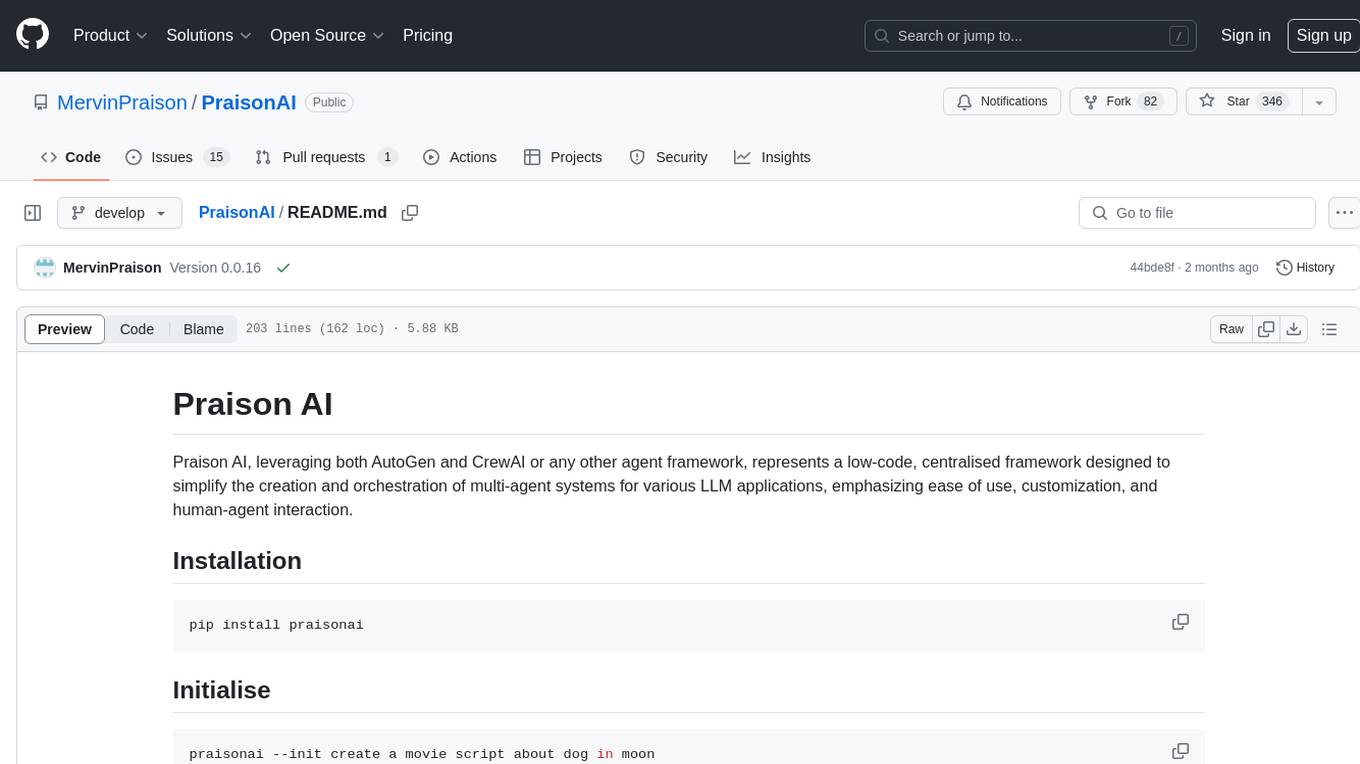
Praison AI is a low-code, centralised framework that simplifies the creation and orchestration of multi-agent systems for various LLM applications. It emphasizes ease of use, customization, and human-agent interaction. The tool leverages AutoGen and CrewAI frameworks to facilitate the development of AI-generated scripts and movie concepts. Users can easily create, run, test, and deploy agents for scriptwriting and movie concept development. Praison AI also provides options for full automatic mode and integration with OpenAI models for enhanced AI capabilities.
README:
PraisonAI is a production-ready Multi-AI Agents framework with self-reflection, designed to create AI Agents to automate and solve problems ranging from simple tasks to complex challenges. By integrating PraisonAI Agents, AutoGen, and CrewAI into a low-code solution, it streamlines the building and management of multi-agent LLM systems, emphasising simplicity, customisation, and effective human-agent collaboration.
- 🤖 Automated AI Agents Creation
- 🔄 Self Reflection AI Agents
- 🧠 Reasoning AI Agents
- 👁️ Multi Modal AI Agents
- 🤝 Multi Agent Collaboration
- 🎭 AI Agent Workflow
- 📚 Add Custom Knowledge
- 🧠 Agents with Short and Long Term Memory
- 📄 Chat with PDF Agents
- 💻 Code Interpreter Agents
- 📚 RAG Agents
- 🤔 Async & Parallel Processing
- 🔄 Auto Agents
- 🔢 Math Agents
- 🎯 Structured Output Agents
- 🔗 LangChain Integrated Agents
- 📞 Callback Agents
- 🤏 Mini AI Agents
- 🛠️ 100+ Custom Tools
- 📄 YAML Configuration
- 💯 100+ LLM Support
Light weight package dedicated for coding:
pip install praisonaiagentsexport OPENAI_API_KEY=xxxxxxxxxxxxxxxxxxxxxxCreate app.py file and add the code below:
from praisonaiagents import Agent
agent = Agent(instructions="Your are a helpful AI assistant")
agent.start("Write a movie script about a robot in Mars")Run:
python app.pyCreate app.py file and add the code below:
from praisonaiagents import Agent, PraisonAIAgents
research_agent = Agent(instructions="Research about AI")
summarise_agent = Agent(instructions="Summarise research agent's findings")
agents = PraisonAIAgents(agents=[research_agent, summarise_agent])
agents.start()Run:
python app.pypip install praisonai
export OPENAI_API_KEY=xxxxxxxxxxxxxxxxxxxxxx
praisonai --auto create a movie script about Robots in Marsnpm install praisonai
export OPENAI_API_KEY=xxxxxxxxxxxxxxxxxxxxxxconst { Agent } = require('praisonai');
const agent = new Agent({ instructions: 'You are a helpful AI assistant' });
agent.start('Write a movie script about a robot in Mars');graph LR
%% Define the main flow
Start([▶ Start]) --> Agent1
Agent1 --> Process[⚙ Process]
Process --> Agent2
Agent2 --> Output([✓ Output])
Process -.-> Agent1
%% Define subgraphs for agents and their tasks
subgraph Agent1[ ]
Task1[📋 Task]
AgentIcon1[🤖 AI Agent]
Tools1[🔧 Tools]
Task1 --- AgentIcon1
AgentIcon1 --- Tools1
end
subgraph Agent2[ ]
Task2[📋 Task]
AgentIcon2[🤖 AI Agent]
Tools2[🔧 Tools]
Task2 --- AgentIcon2
AgentIcon2 --- Tools2
end
classDef input fill:#8B0000,stroke:#7C90A0,color:#fff
classDef process fill:#189AB4,stroke:#7C90A0,color:#fff
classDef tools fill:#2E8B57,stroke:#7C90A0,color:#fff
classDef transparent fill:none,stroke:none
class Start,Output,Task1,Task2 input
class Process,AgentIcon1,AgentIcon2 process
class Tools1,Tools2 tools
class Agent1,Agent2 transparentCreate AI agents that can use tools to interact with external systems and perform actions.
flowchart TB
subgraph Tools
direction TB
T3[Internet Search]
T1[Code Execution]
T2[Formatting]
end
Input[Input] ---> Agents
subgraph Agents
direction LR
A1[Agent 1]
A2[Agent 2]
A3[Agent 3]
end
Agents ---> Output[Output]
T3 --> A1
T1 --> A2
T2 --> A3
style Tools fill:#189AB4,color:#fff
style Agents fill:#8B0000,color:#fff
style Input fill:#8B0000,color:#fff
style Output fill:#8B0000,color:#fffCreate AI agents with memory capabilities for maintaining context and information across tasks.
flowchart TB
subgraph Memory
direction TB
STM[Short Term]
LTM[Long Term]
end
subgraph Store
direction TB
DB[(Vector DB)]
end
Input[Input] ---> Agents
subgraph Agents
direction LR
A1[Agent 1]
A2[Agent 2]
A3[Agent 3]
end
Agents ---> Output[Output]
Memory <--> Store
Store <--> A1
Store <--> A2
Store <--> A3
style Memory fill:#189AB4,color:#fff
style Store fill:#2E8B57,color:#fff
style Agents fill:#8B0000,color:#fff
style Input fill:#8B0000,color:#fff
style Output fill:#8B0000,color:#fffThe simplest form of task execution where tasks are performed one after another.
graph LR
Input[Input] --> A1
subgraph Agents
direction LR
A1[Agent 1] --> A2[Agent 2] --> A3[Agent 3]
end
A3 --> Output[Output]
classDef input fill:#8B0000,stroke:#7C90A0,color:#fff
classDef process fill:#189AB4,stroke:#7C90A0,color:#fff
classDef transparent fill:none,stroke:none
class Input,Output input
class A1,A2,A3 process
class Agents transparentUses a manager agent to coordinate task execution and agent assignments.
graph TB
Input[Input] --> Manager
subgraph Agents
Manager[Manager Agent]
subgraph Workers
direction LR
W1[Worker 1]
W2[Worker 2]
W3[Worker 3]
end
Manager --> W1
Manager --> W2
Manager --> W3
end
W1 --> Manager
W2 --> Manager
W3 --> Manager
Manager --> Output[Output]
classDef input fill:#8B0000,stroke:#7C90A0,color:#fff
classDef process fill:#189AB4,stroke:#7C90A0,color:#fff
classDef transparent fill:none,stroke:none
class Input,Output input
class Manager,W1,W2,W3 process
class Agents,Workers transparentAdvanced process type supporting complex task relationships and conditional execution.
graph LR
Input[Input] --> Start
subgraph Workflow
direction LR
Start[Start] --> C1{Condition}
C1 --> |Yes| A1[Agent 1]
C1 --> |No| A2[Agent 2]
A1 --> Join
A2 --> Join
Join --> A3[Agent 3]
end
A3 --> Output[Output]
classDef input fill:#8B0000,stroke:#7C90A0,color:#fff
classDef process fill:#189AB4,stroke:#7C90A0,color:#fff
classDef decision fill:#2E8B57,stroke:#7C90A0,color:#fff
classDef transparent fill:none,stroke:none
class Input,Output input
class Start,A1,A2,A3,Join process
class C1 decision
class Workflow transparentCreate AI agents that can dynamically route tasks to specialized LLM instances.
flowchart LR
In[In] --> Router[LLM Call Router]
Router --> LLM1[LLM Call 1]
Router --> LLM2[LLM Call 2]
Router --> LLM3[LLM Call 3]
LLM1 --> Out[Out]
LLM2 --> Out
LLM3 --> Out
style In fill:#8B0000,color:#fff
style Router fill:#2E8B57,color:#fff
style LLM1 fill:#2E8B57,color:#fff
style LLM2 fill:#2E8B57,color:#fff
style LLM3 fill:#2E8B57,color:#fff
style Out fill:#8B0000,color:#fffCreate AI agents that orchestrate and distribute tasks among specialized workers.
flowchart LR
In[In] --> Router[LLM Call Router]
Router --> LLM1[LLM Call 1]
Router --> LLM2[LLM Call 2]
Router --> LLM3[LLM Call 3]
LLM1 --> Synthesizer[Synthesizer]
LLM2 --> Synthesizer
LLM3 --> Synthesizer
Synthesizer --> Out[Out]
style In fill:#8B0000,color:#fff
style Router fill:#2E8B57,color:#fff
style LLM1 fill:#2E8B57,color:#fff
style LLM2 fill:#2E8B57,color:#fff
style LLM3 fill:#2E8B57,color:#fff
style Synthesizer fill:#2E8B57,color:#fff
style Out fill:#8B0000,color:#fffCreate AI agents that can autonomously monitor, act, and adapt based on environment feedback.
flowchart LR
Human[Human] <--> LLM[LLM Call]
LLM -->|ACTION| Environment[Environment]
Environment -->|FEEDBACK| LLM
LLM --> Stop[Stop]
style Human fill:#8B0000,color:#fff
style LLM fill:#2E8B57,color:#fff
style Environment fill:#8B0000,color:#fff
style Stop fill:#333,color:#fffCreate AI agents that can execute tasks in parallel for improved performance.
flowchart LR
In[In] --> LLM2[LLM Call 2]
In --> LLM1[LLM Call 1]
In --> LLM3[LLM Call 3]
LLM1 --> Aggregator[Aggregator]
LLM2 --> Aggregator
LLM3 --> Aggregator
Aggregator --> Out[Out]
style In fill:#8B0000,color:#fff
style LLM1 fill:#2E8B57,color:#fff
style LLM2 fill:#2E8B57,color:#fff
style LLM3 fill:#2E8B57,color:#fff
style Aggregator fill:#fff,color:#000
style Out fill:#8B0000,color:#fffCreate AI agents with sequential prompt chaining for complex workflows.
flowchart LR
In[In] --> LLM1[LLM Call 1] --> Gate{Gate}
Gate -->|Pass| LLM2[LLM Call 2] -->|Output 2| LLM3[LLM Call 3] --> Out[Out]
Gate -->|Fail| Exit[Exit]
style In fill:#8B0000,color:#fff
style LLM1 fill:#2E8B57,color:#fff
style LLM2 fill:#2E8B57,color:#fff
style LLM3 fill:#2E8B57,color:#fff
style Out fill:#8B0000,color:#fff
style Exit fill:#8B0000,color:#fffCreate AI agents that can generate and optimize solutions through iterative feedback.
flowchart LR
In[In] --> Generator[LLM Call Generator]
Generator -->|SOLUTION| Evaluator[LLM Call Evaluator] -->|ACCEPTED| Out[Out]
Evaluator -->|REJECTED + FEEDBACK| Generator
style In fill:#8B0000,color:#fff
style Generator fill:#2E8B57,color:#fff
style Evaluator fill:#2E8B57,color:#fff
style Out fill:#8B0000,color:#fffCreate AI agents that can efficiently handle repetitive tasks through automated loops.
flowchart LR
In[Input] --> LoopAgent[("Looping Agent")]
LoopAgent --> Task[Task]
Task --> |Next iteration| LoopAgent
Task --> |Done| Out[Output]
style In fill:#8B0000,color:#fff
style LoopAgent fill:#2E8B57,color:#fff,shape:circle
style Task fill:#2E8B57,color:#fff
style Out fill:#8B0000,color:#fffexport OPENAI_BASE_URL=http://localhost:11434/v1Replace xxxx with Groq API KEY:
export OPENAI_API_KEY=xxxxxxxxxxx
export OPENAI_BASE_URL=https://api.groq.com/openai/v1Create agents.yaml file and add the code below:
framework: praisonai
topic: Artificial Intelligence
roles:
screenwriter:
backstory: "Skilled in crafting scripts with engaging dialogue about {topic}."
goal: Create scripts from concepts.
role: Screenwriter
tasks:
scriptwriting_task:
description: "Develop scripts with compelling characters and dialogue about {topic}."
expected_output: "Complete script ready for production."To run the playbook:
praisonai agents.yamlBelow is used for development only.
# Install uv if you haven't already
pip install uv
# Install from requirements
uv pip install -r pyproject.toml
# Install with extras
uv pip install -r pyproject.toml --extra code
uv pip install -r pyproject.toml --extra "crewai,autogen"- Fork on GitHub: Use the "Fork" button on the repository page.
- Clone your fork:
git clone https://github.com/yourusername/praisonAI.git - Create a branch:
git checkout -b new-feature - Make changes and commit:
git commit -am "Add some feature" - Push to your fork:
git push origin new-feature - Submit a pull request via GitHub's web interface.
- Await feedback from project maintainers.
- 🔄 Use CrewAI or AutoGen Framework
- 💻 Chat with ENTIRE Codebase
- 🎨 Interactive UIs
- 📄 YAML-based Configuration
- 🛠️ Custom Tool Integration
- 🔍 Internet Search Capability (using Crawl4AI and Tavily)
- 🖼️ Vision Language Model (VLM) Support
- 🎙️ Real-time Voice Interaction
For Tasks:
Click tags to check more tools for each tasksFor Jobs:
Alternative AI tools for PraisonAI
Similar Open Source Tools

PraisonAI
Praison AI is a low-code, centralised framework that simplifies the creation and orchestration of multi-agent systems for various LLM applications. It emphasizes ease of use, customization, and human-agent interaction. The tool leverages AutoGen and CrewAI frameworks to facilitate the development of AI-generated scripts and movie concepts. Users can easily create, run, test, and deploy agents for scriptwriting and movie concept development. Praison AI also provides options for full automatic mode and integration with OpenAI models for enhanced AI capabilities.
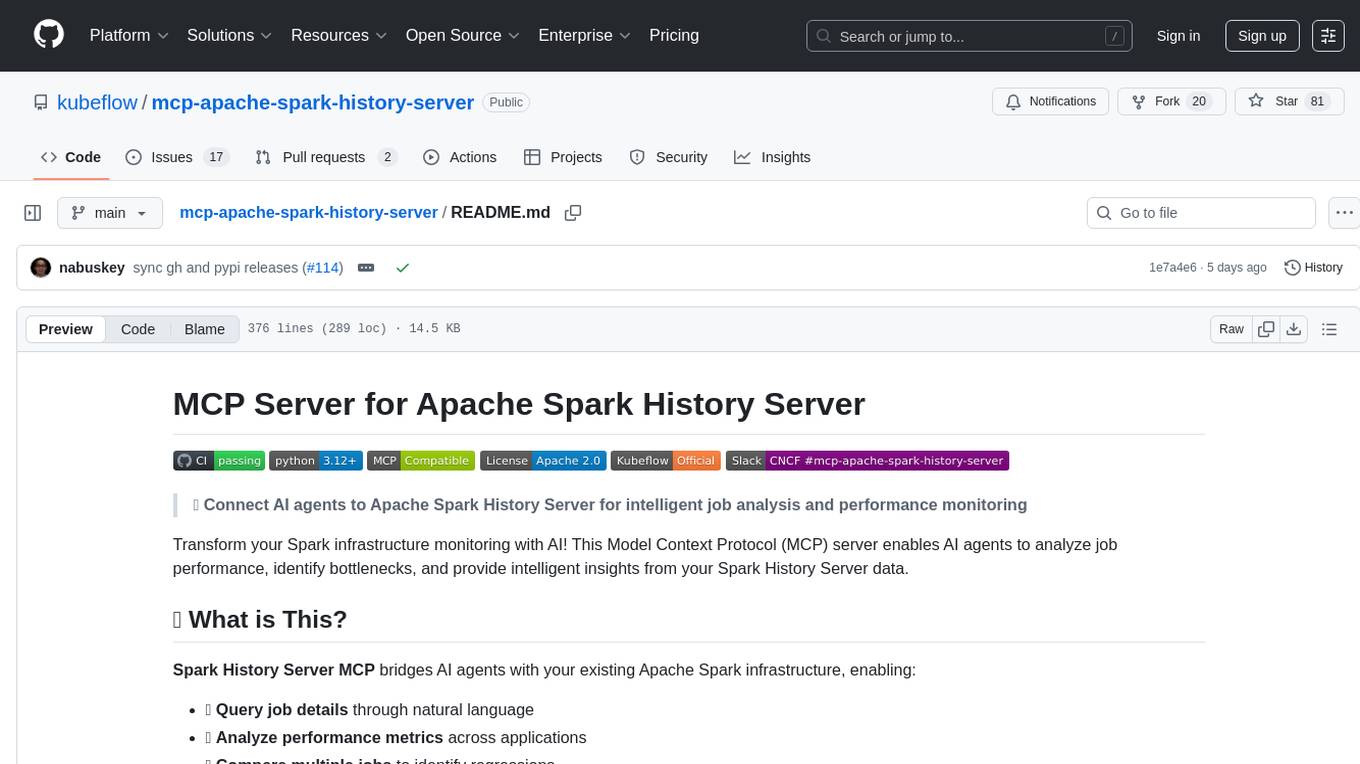
mcp-apache-spark-history-server
The MCP Server for Apache Spark History Server is a tool that connects AI agents to Apache Spark History Server for intelligent job analysis and performance monitoring. It enables AI agents to analyze job performance, identify bottlenecks, and provide insights from Spark History Server data. The server bridges AI agents with existing Apache Spark infrastructure, allowing users to query job details, analyze performance metrics, compare multiple jobs, investigate failures, and generate insights from historical execution data.
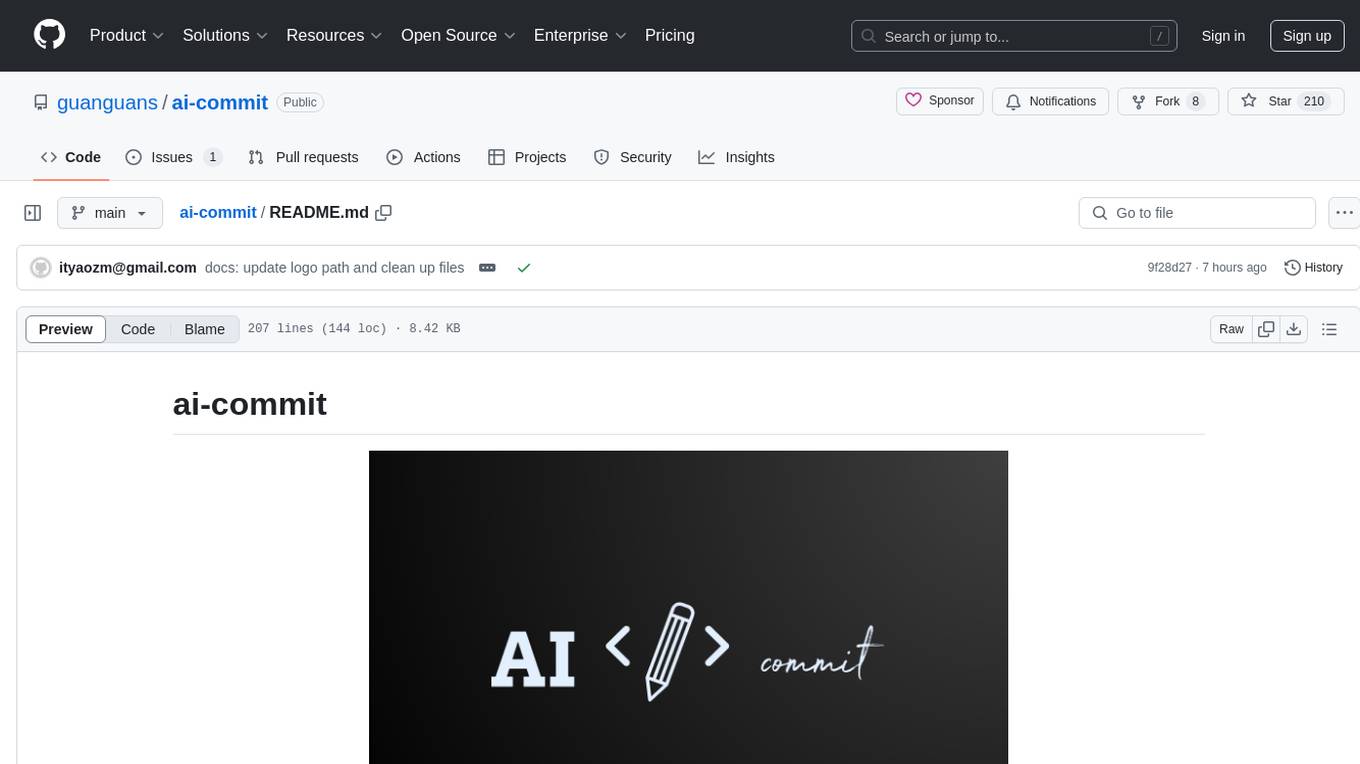
ai-commit
ai-commit is a tool that automagically generates conventional git commit messages using AI. It supports various generators like Bito Cli, ERNIE-Bot-turbo, ERNIE-Bot, Moonshot, and OpenAI Chat. The tool requires PHP version 7.3 or higher for installation. Users can configure generators, set API keys, and easily generate and commit messages with customizable options. Additionally, ai-commit provides commands for managing configurations, self-updating, and shell completion scripts.
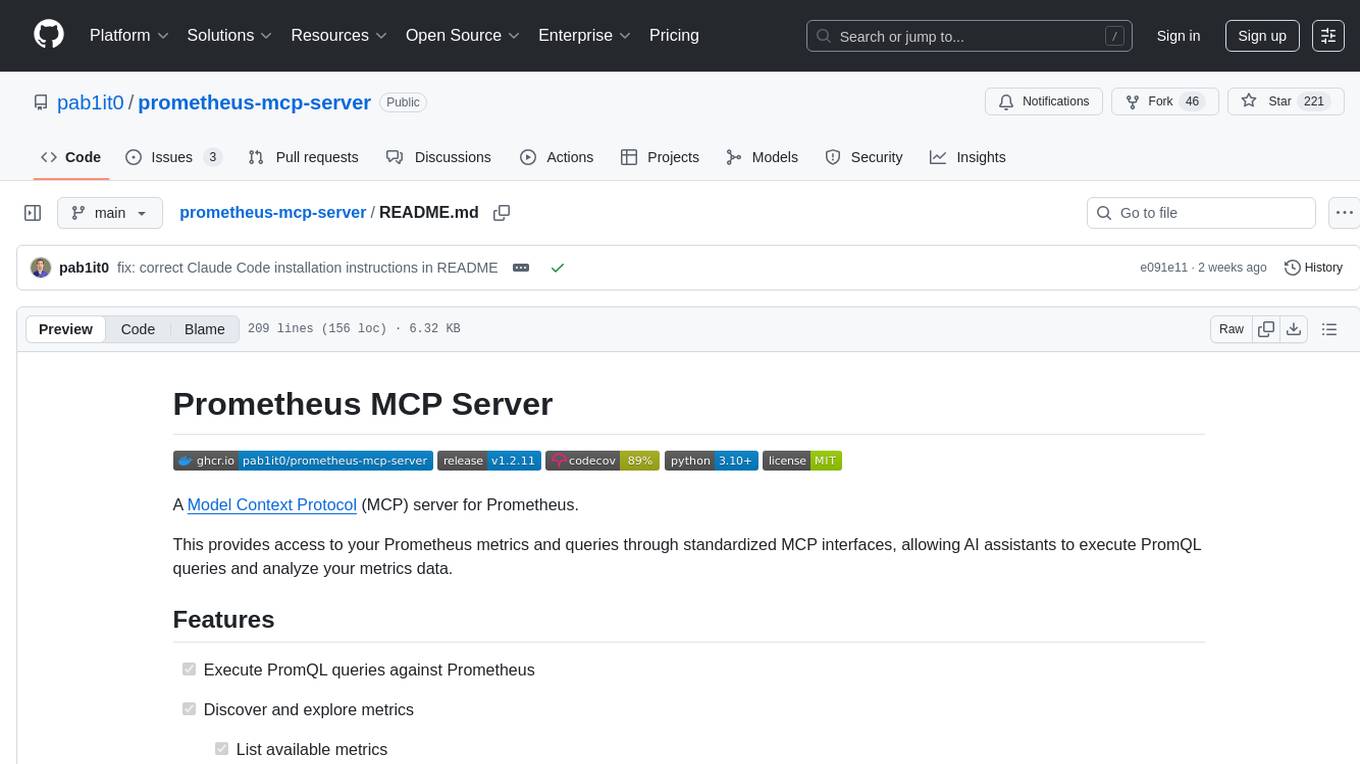
prometheus-mcp-server
Prometheus MCP Server is a Model Context Protocol (MCP) server that provides access to Prometheus metrics and queries through standardized interfaces. It allows AI assistants to execute PromQL queries and analyze metrics data. The server supports executing queries, exploring metrics, listing available metrics, viewing query results, and authentication. It offers interactive tools for AI assistants and can be configured to choose specific tools. Installation methods include using Docker Desktop, MCP-compatible clients like Claude Desktop, VS Code, Cursor, and Windsurf, and manual Docker setup. Configuration options include setting Prometheus server URL, authentication credentials, organization ID, transport mode, and bind host/port. Contributions are welcome, and the project uses `uv` for managing dependencies and includes a comprehensive test suite for functionality testing.
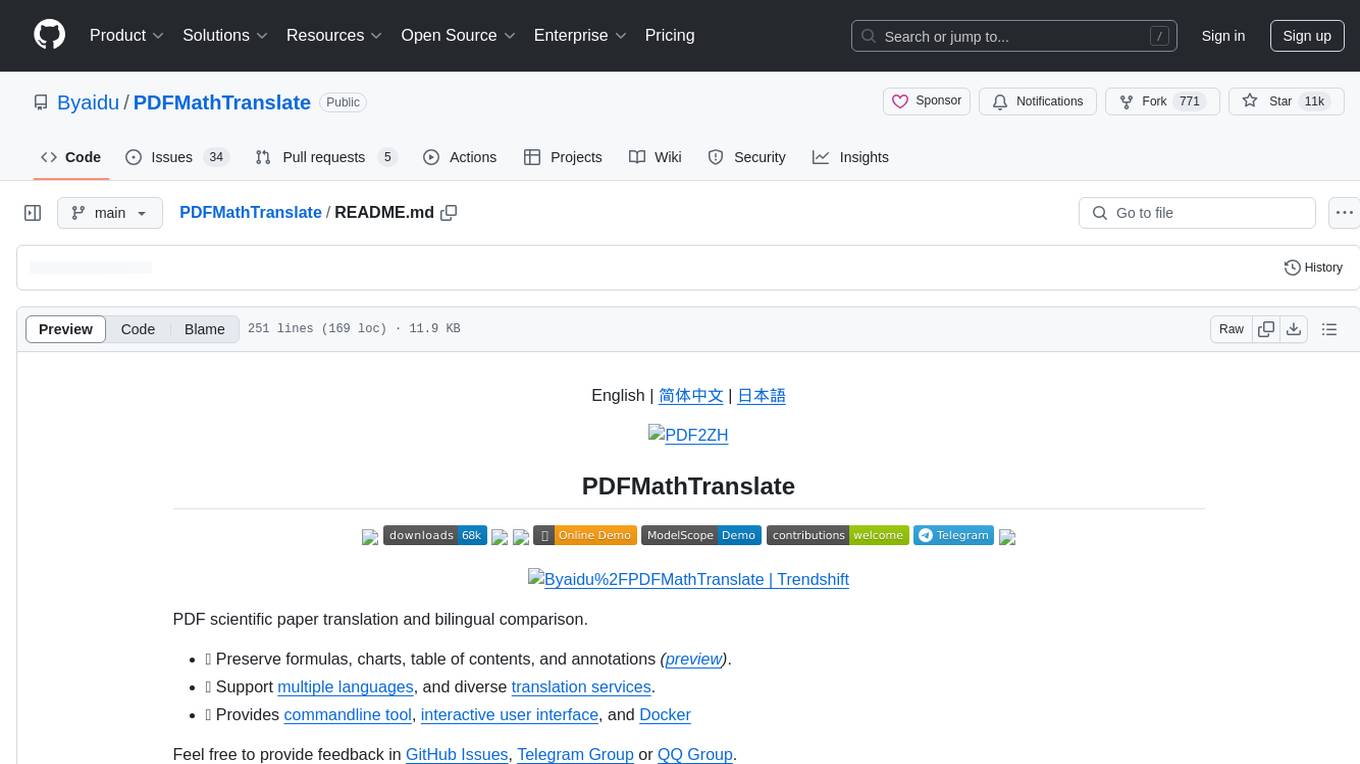
PDFMathTranslate
PDFMathTranslate is a tool designed for translating scientific papers and conducting bilingual comparisons. It preserves formulas, charts, table of contents, and annotations. The tool supports multiple languages and diverse translation services. It provides a command-line tool, interactive user interface, and Docker deployment. Users can try the application through online demos. The tool offers various installation methods including command-line, portable, graphic user interface, and Docker. Advanced options allow users to customize translation settings. Additionally, the tool supports secondary development through APIs for Python and HTTP. Future plans include parsing layout with DocLayNet based models, fixing page rotation and format issues, supporting non-PDF/A files, and integrating plugins for Zotero and Obsidian.
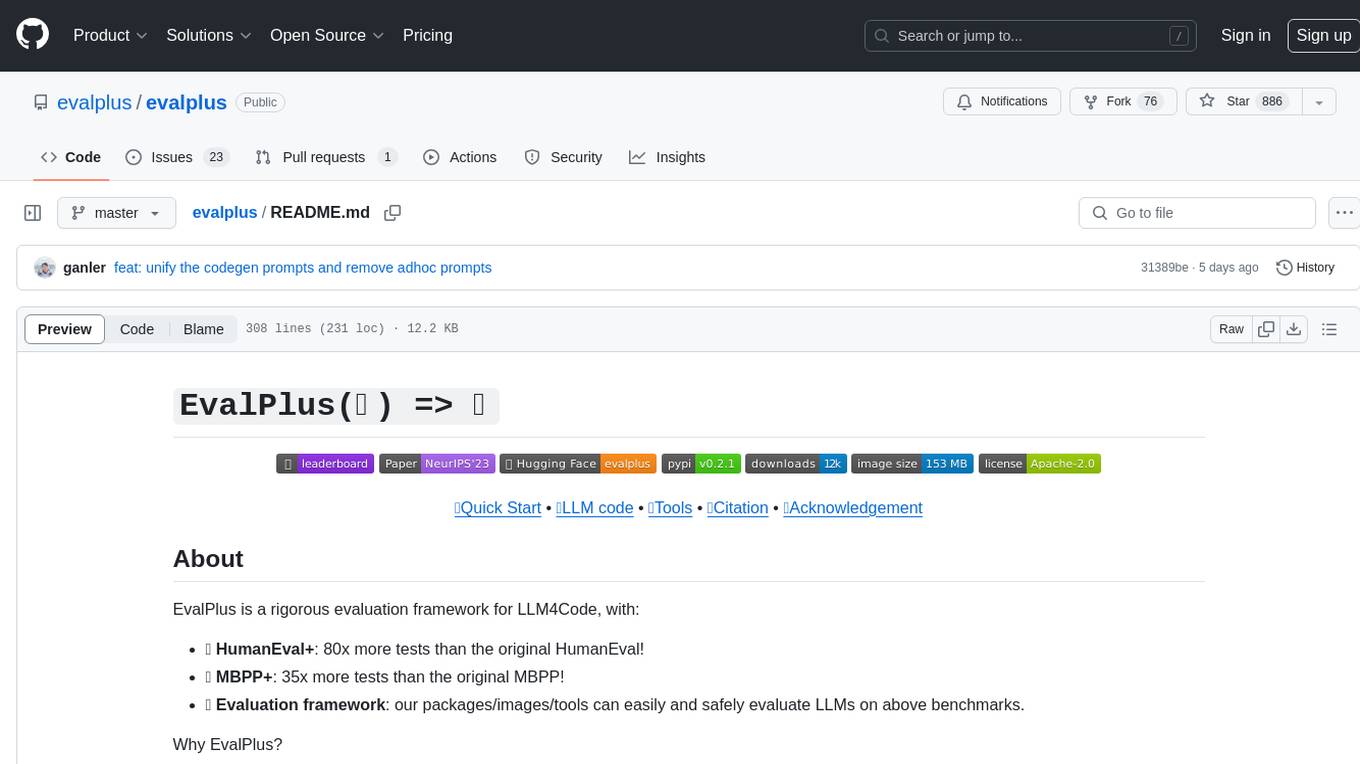
evalplus
EvalPlus is a rigorous evaluation framework for LLM4Code, providing HumanEval+ and MBPP+ tests to evaluate large language models on code generation tasks. It offers precise evaluation and ranking, coding rigorousness analysis, and pre-generated code samples. Users can use EvalPlus to generate code solutions, post-process code, and evaluate code quality. The tool includes tools for code generation and test input generation using various backends.
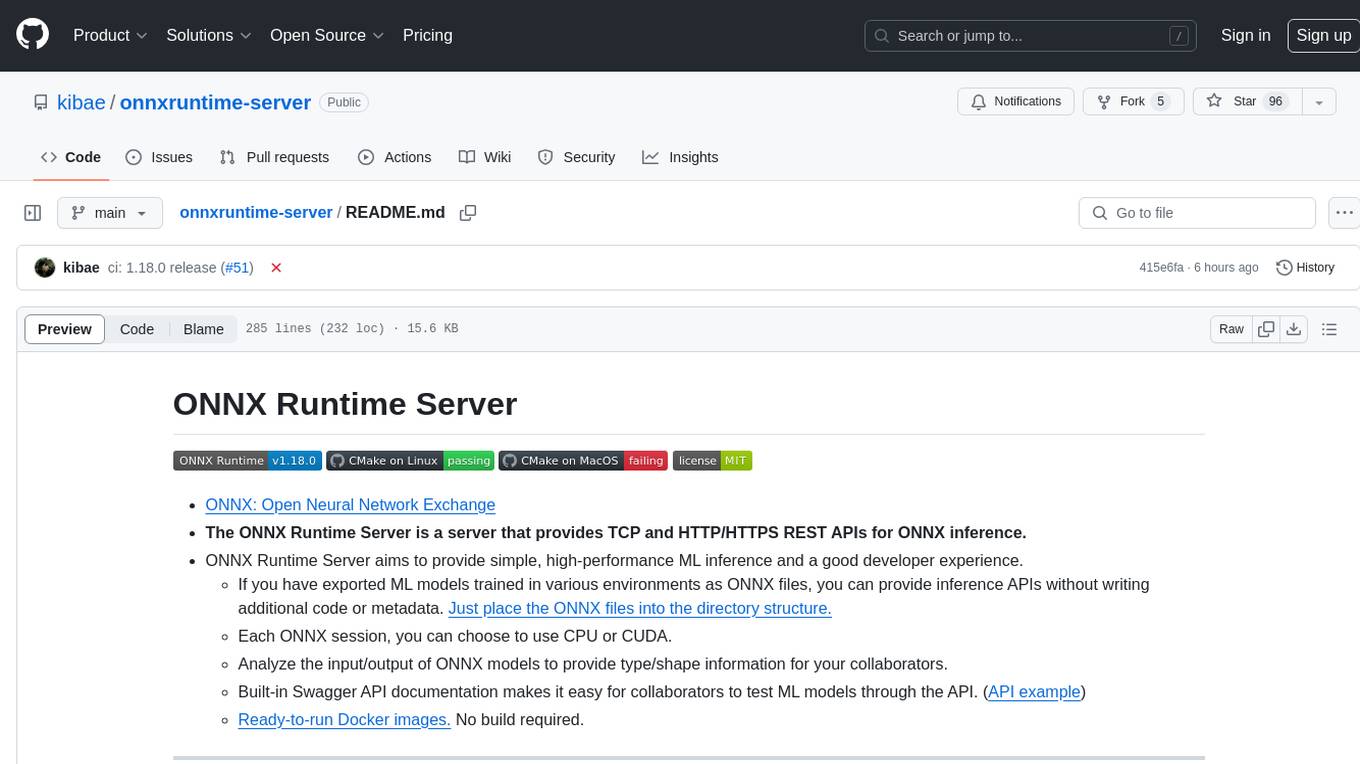
onnxruntime-server
ONNX Runtime Server is a server that provides TCP and HTTP/HTTPS REST APIs for ONNX inference. It aims to offer simple, high-performance ML inference and a good developer experience. Users can provide inference APIs for ONNX models without writing additional code by placing the models in the directory structure. Each session can choose between CPU or CUDA, analyze input/output, and provide Swagger API documentation for easy testing. Ready-to-run Docker images are available, making it convenient to deploy the server.
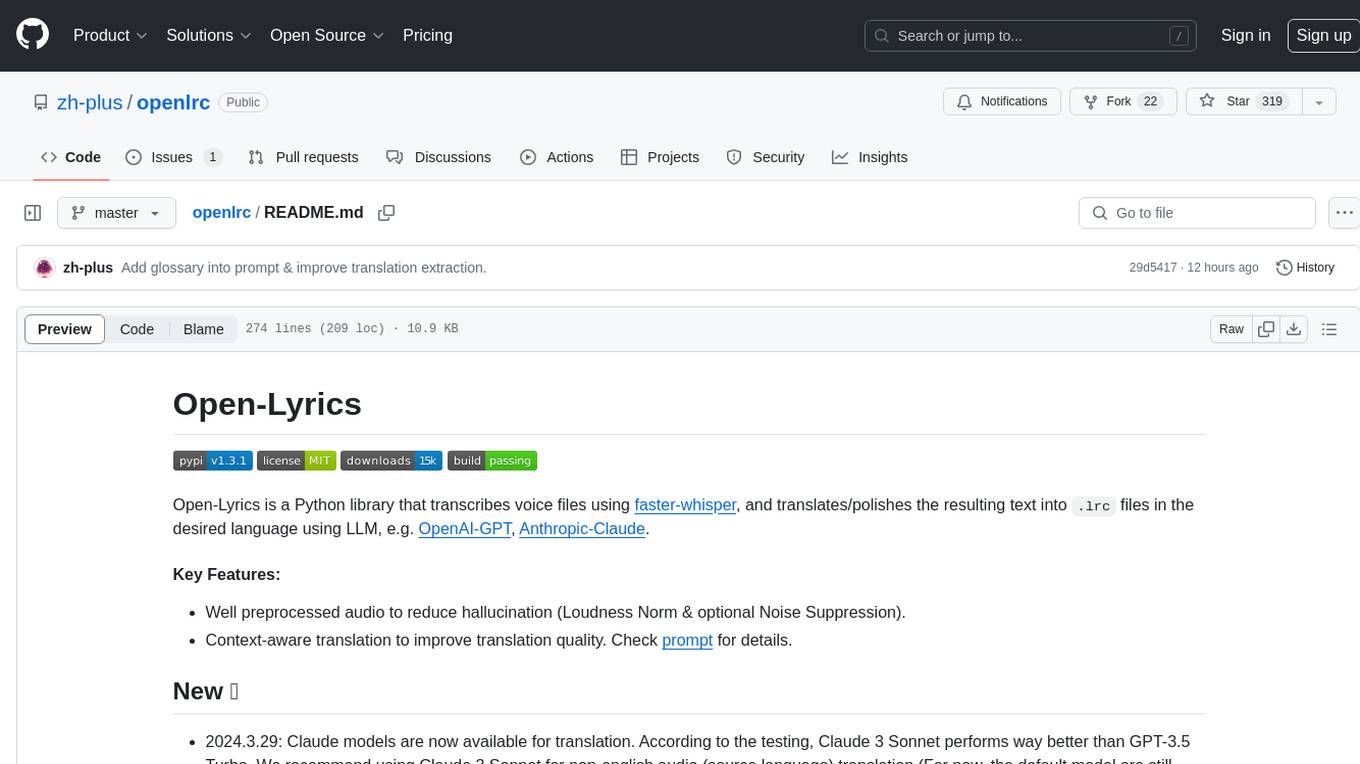
openlrc
Open-Lyrics is a Python library that transcribes voice files using faster-whisper and translates/polishes the resulting text into `.lrc` files in the desired language using LLM, e.g. OpenAI-GPT, Anthropic-Claude. It offers well preprocessed audio to reduce hallucination and context-aware translation to improve translation quality. Users can install the library from PyPI or GitHub and follow the installation steps to set up the environment. The tool supports GUI usage and provides Python code examples for transcription and translation tasks. It also includes features like utilizing context and glossary for translation enhancement, pricing information for different models, and a list of todo tasks for future improvements.
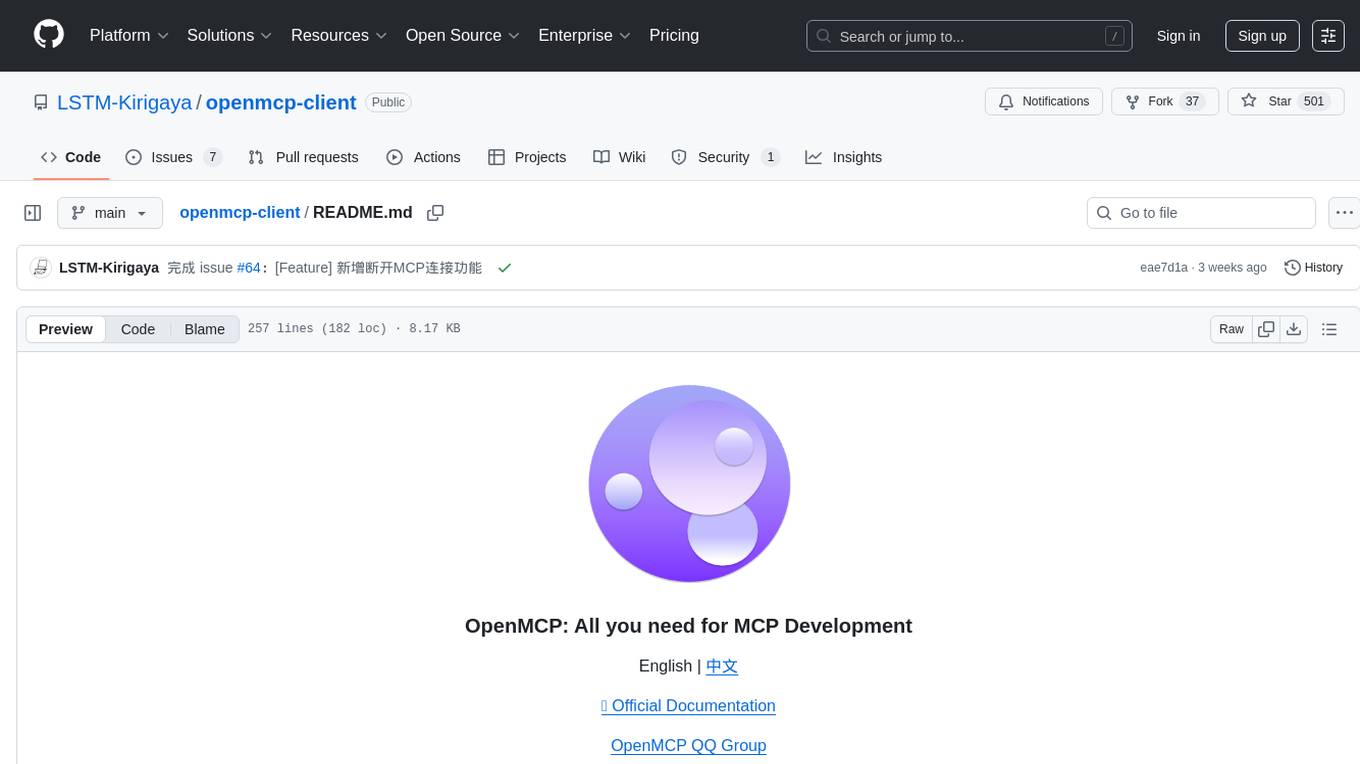
openmcp-client
OpenMCP is an integrated plugin for MCP server debugging in vscode/trae/cursor, combining development and testing functionalities. It includes tools for testing MCP resources, managing large model interactions, project-level management, and supports multiple large models. The openmcp-sdk allows for deploying MCP as an agent app with easy configuration and execution of tasks. The project follows a modular design allowing implementation in different modes on various platforms.

BricksLLM
BricksLLM is a cloud native AI gateway written in Go. Currently, it provides native support for OpenAI, Anthropic, Azure OpenAI and vLLM. BricksLLM aims to provide enterprise level infrastructure that can power any LLM production use cases. Here are some use cases for BricksLLM: * Set LLM usage limits for users on different pricing tiers * Track LLM usage on a per user and per organization basis * Block or redact requests containing PIIs * Improve LLM reliability with failovers, retries and caching * Distribute API keys with rate limits and cost limits for internal development/production use cases * Distribute API keys with rate limits and cost limits for students
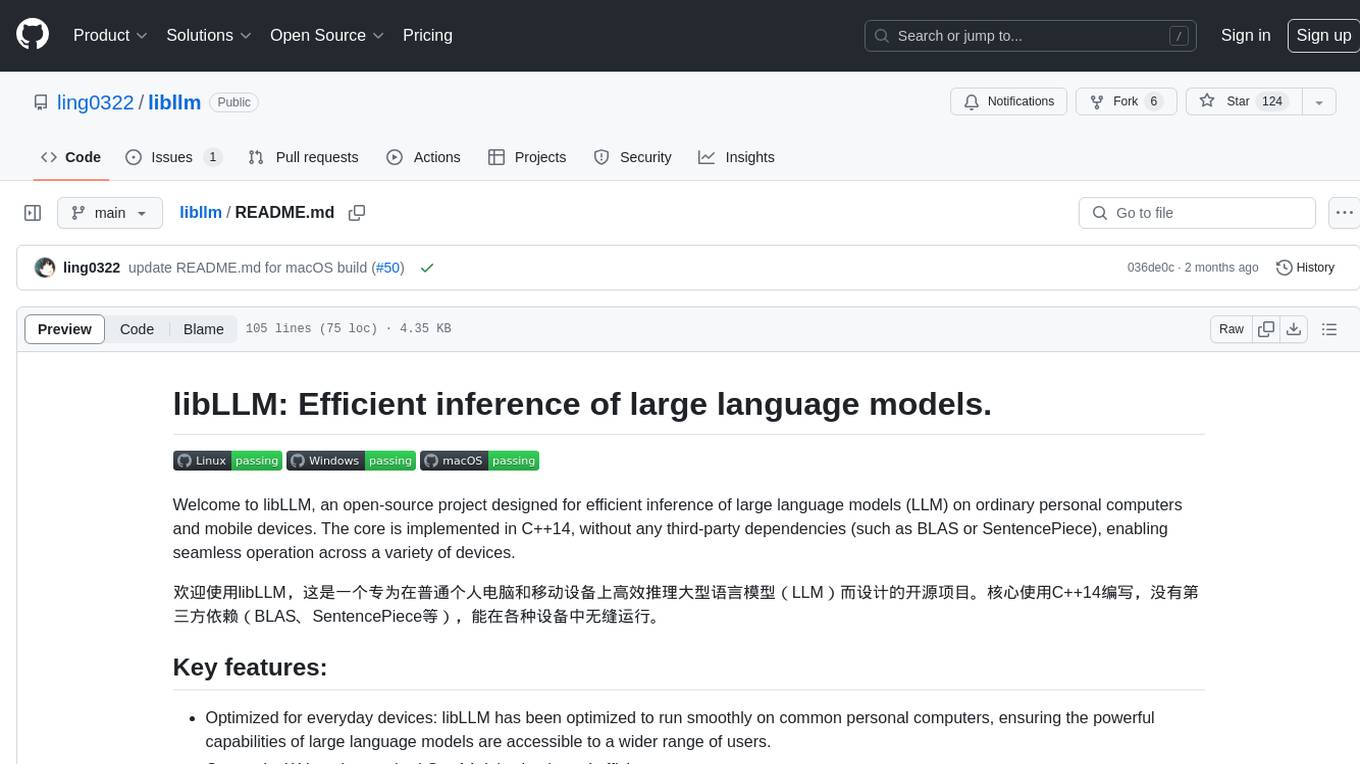
libllm
libLLM is an open-source project designed for efficient inference of large language models (LLM) on personal computers and mobile devices. It is optimized to run smoothly on common devices, written in C++14 without external dependencies, and supports CUDA for accelerated inference. Users can build the tool for CPU only or with CUDA support, and run libLLM from the command line. Additionally, there are API examples available for Python and the tool can export Huggingface models.
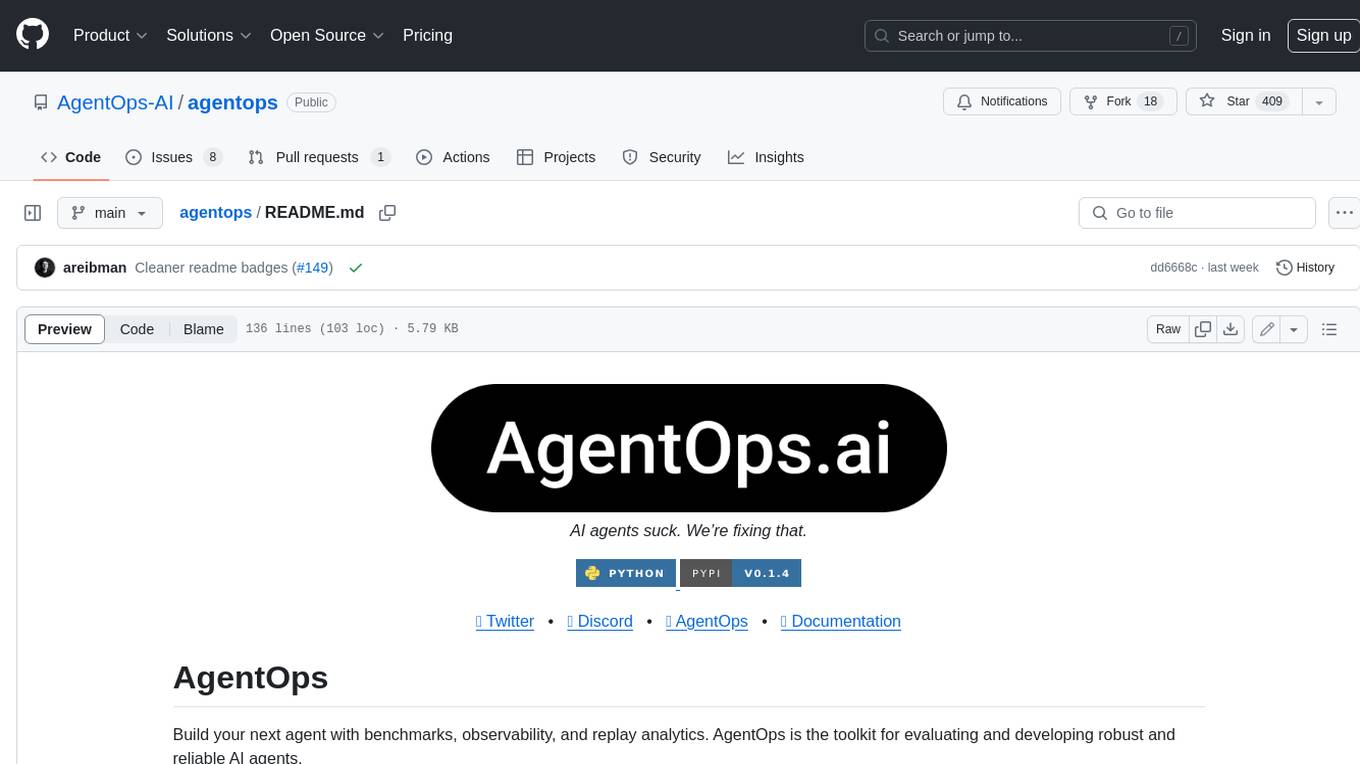
agentops
AgentOps is a toolkit for evaluating and developing robust and reliable AI agents. It provides benchmarks, observability, and replay analytics to help developers build better agents. AgentOps is open beta and can be signed up for here. Key features of AgentOps include: - Session replays in 3 lines of code: Initialize the AgentOps client and automatically get analytics on every LLM call. - Time travel debugging: (coming soon!) - Agent Arena: (coming soon!) - Callback handlers: AgentOps works seamlessly with applications built using Langchain and LlamaIndex.
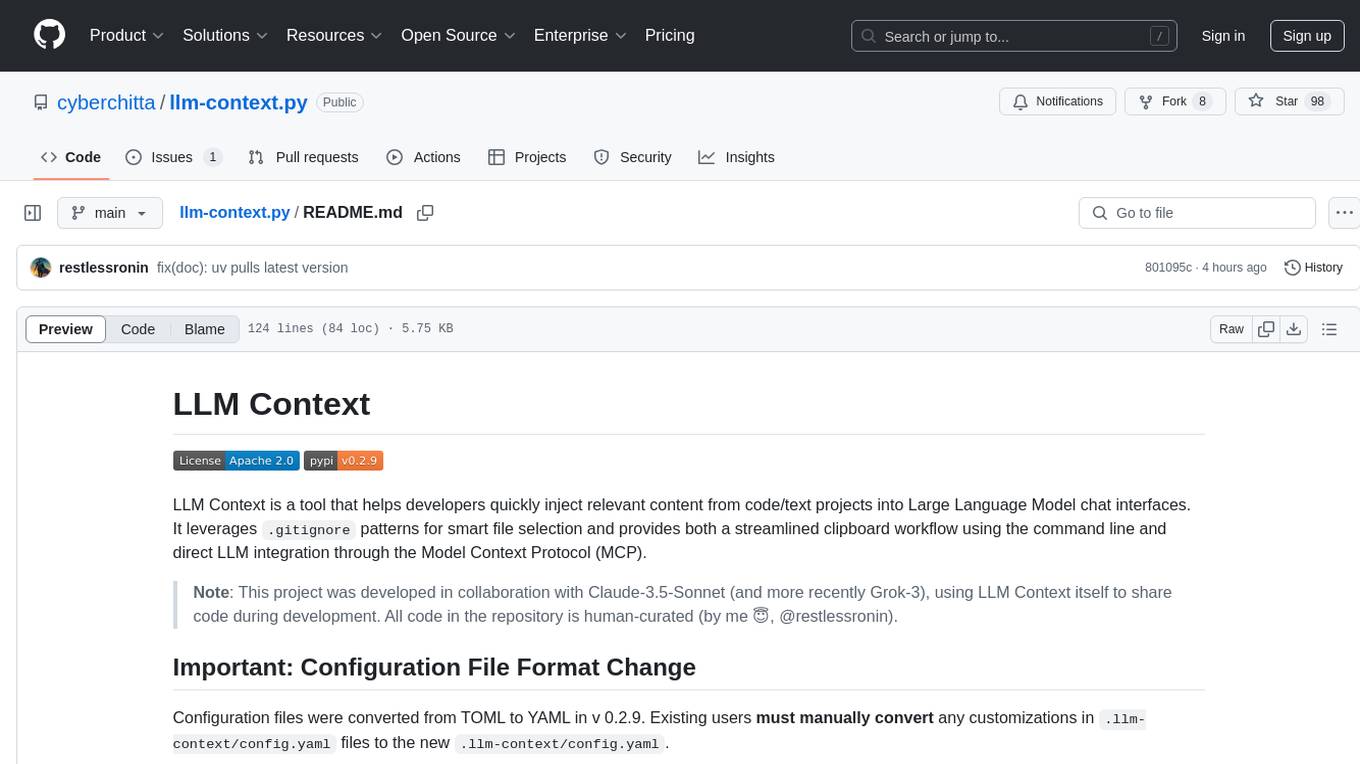
llm-context.py
LLM Context is a tool designed to assist developers in quickly injecting relevant content from code/text projects into Large Language Model chat interfaces. It leverages `.gitignore` patterns for smart file selection and offers a streamlined clipboard workflow using the command line. The tool also provides direct integration with Large Language Models through the Model Context Protocol (MCP). LLM Context is optimized for code repositories and collections of text/markdown/html documents, making it suitable for developers working on projects that fit within an LLM's context window. The tool is under active development and aims to enhance AI-assisted development workflows by harnessing the power of Large Language Models.
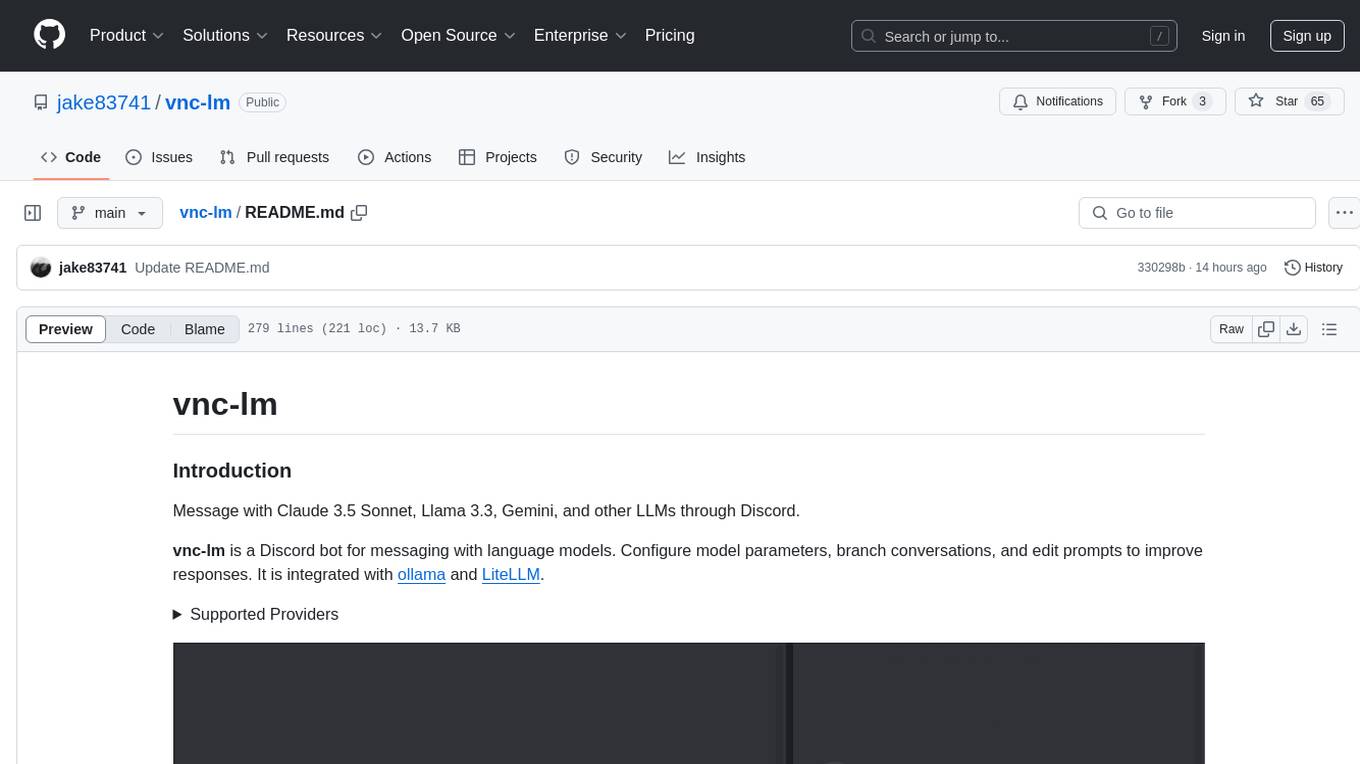
vnc-lm
vnc-lm is a Discord bot designed for messaging with language models. Users can configure model parameters, branch conversations, and edit prompts to enhance responses. The bot supports various providers like OpenAI, Huggingface, and Cloudflare Workers AI. It integrates with ollama and LiteLLM, allowing users to access a wide range of language model APIs through a single interface. Users can manage models, switch between models, split long messages, and create conversation branches. LiteLLM integration enables support for OpenAI-compatible APIs and local LLM services. The bot requires Docker for installation and can be configured through environment variables. Troubleshooting tips are provided for common issues like context window problems, Discord API errors, and LiteLLM issues.
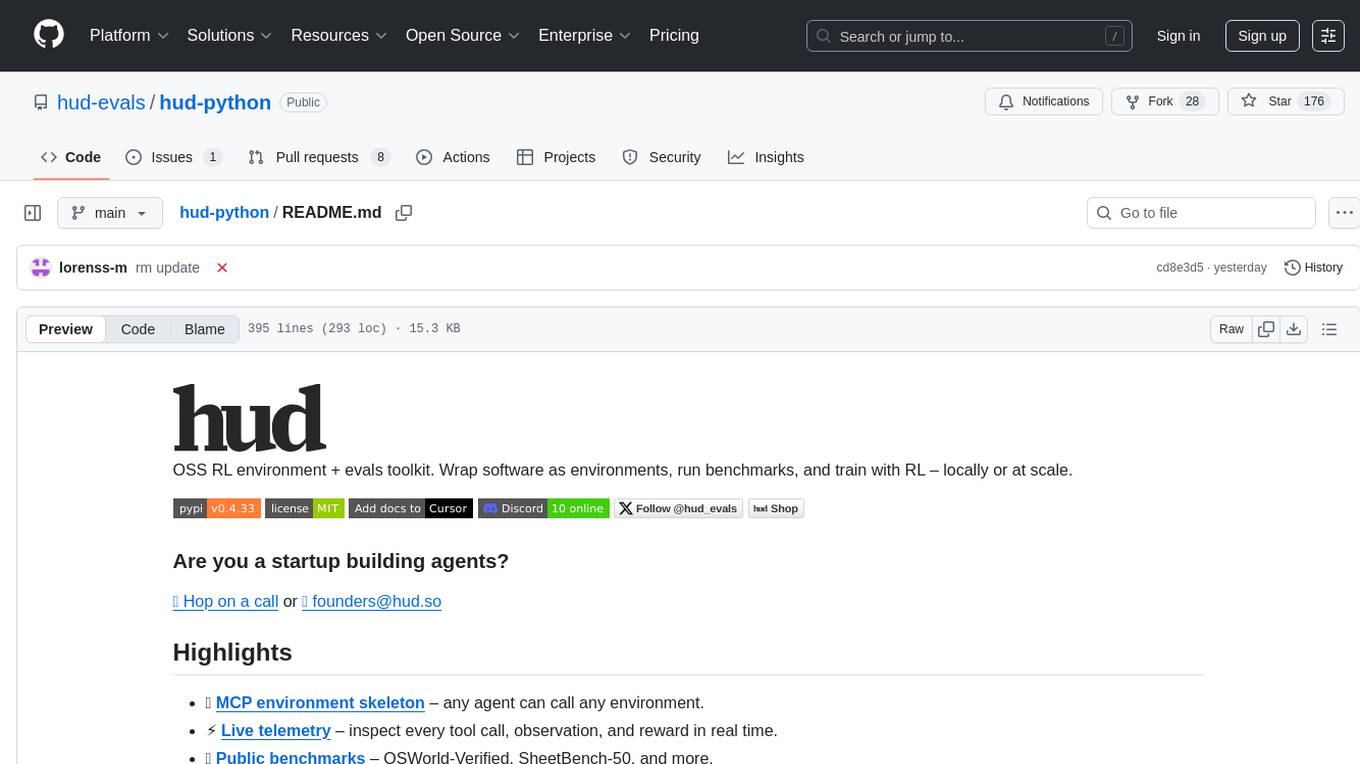
hud-python
hud-python is a Python library for creating interactive heads-up displays (HUDs) in video games. It provides a simple and flexible way to overlay information on the screen, such as player health, score, and notifications. The library is designed to be easy to use and customizable, allowing game developers to enhance the user experience by adding dynamic elements to their games. With hud-python, developers can create engaging HUDs that improve gameplay and provide important feedback to players.
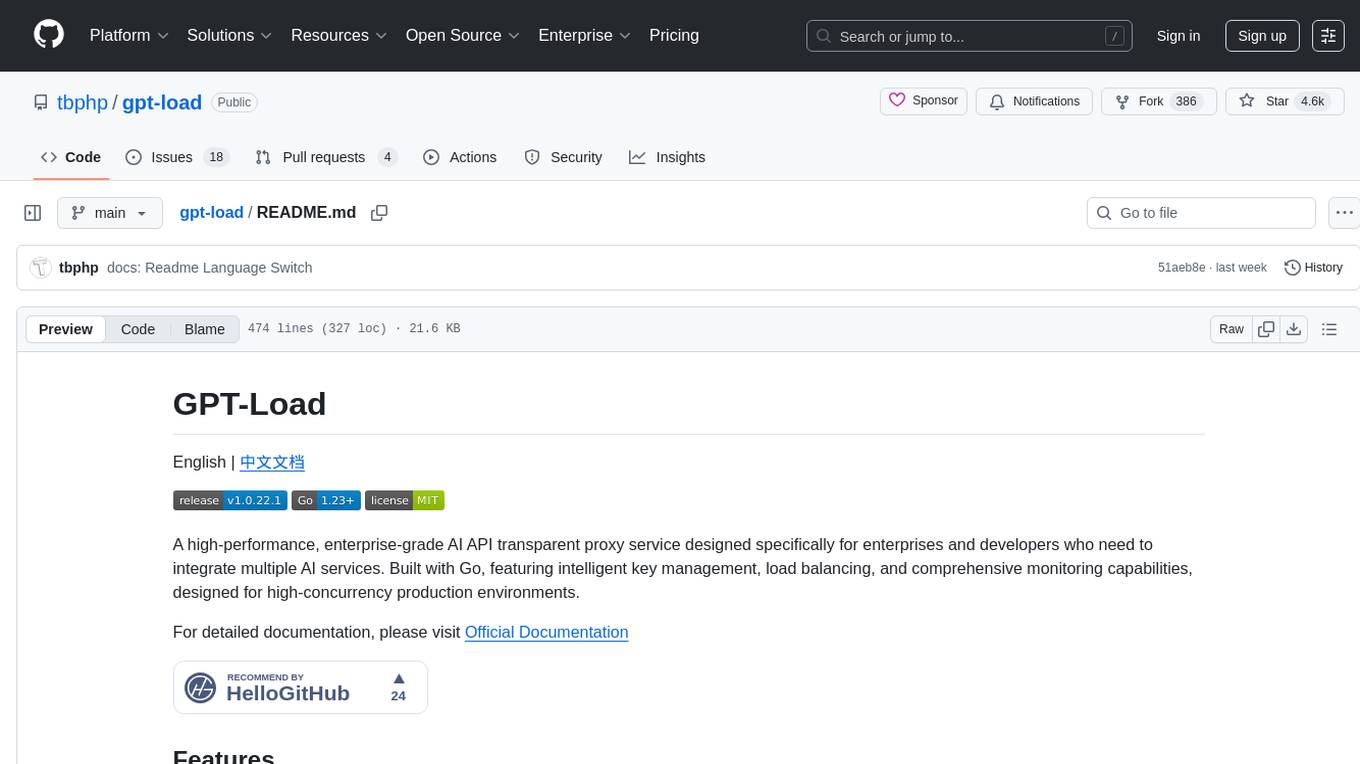
gpt-load
GPT-Load is a high-performance, enterprise-grade AI API transparent proxy service designed for enterprises and developers needing to integrate multiple AI services. Built with Go, it features intelligent key management, load balancing, and comprehensive monitoring capabilities for high-concurrency production environments. The tool serves as a transparent proxy service, preserving native API formats of various AI service providers like OpenAI, Google Gemini, and Anthropic Claude. It supports dynamic configuration, distributed leader-follower deployment, and a Vue 3-based web management interface. GPT-Load is production-ready with features like dual authentication, graceful shutdown, and error recovery.
For similar tasks
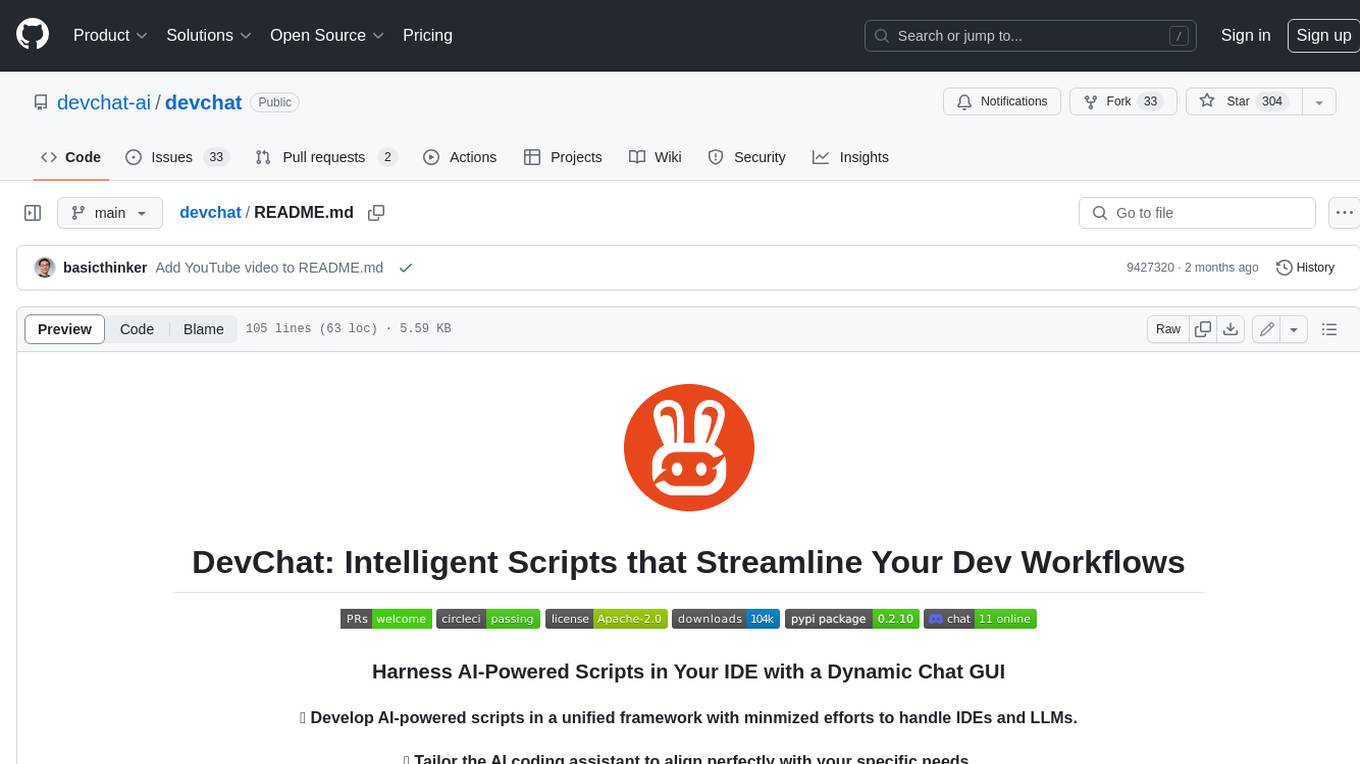
devchat
DevChat is an open-source workflow engine that enables developers to create intelligent, automated workflows for engaging with users through a chat panel within their IDEs. It combines script writing flexibility, latest AI models, and an intuitive chat GUI to enhance user experience and productivity. DevChat simplifies the integration of AI in software development, unlocking new possibilities for developers.

PraisonAI
Praison AI is a low-code, centralised framework that simplifies the creation and orchestration of multi-agent systems for various LLM applications. It emphasizes ease of use, customization, and human-agent interaction. The tool leverages AutoGen and CrewAI frameworks to facilitate the development of AI-generated scripts and movie concepts. Users can easily create, run, test, and deploy agents for scriptwriting and movie concept development. Praison AI also provides options for full automatic mode and integration with OpenAI models for enhanced AI capabilities.
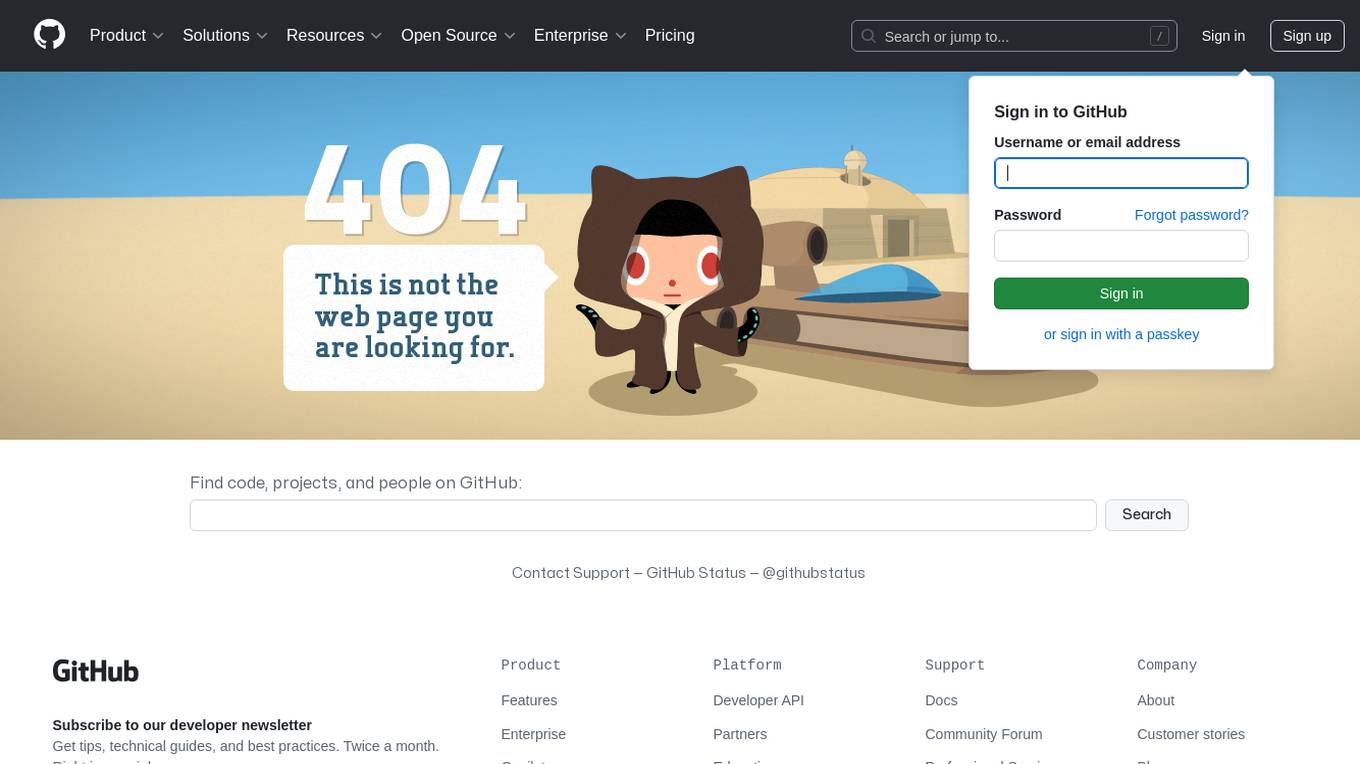
Wave-Executor
Wave Executor is a cutting-edge Roblox script executor designed for advanced script execution, optimized performance, and seamless user experience. Fully compatible with the latest Roblox updates, it is secure, easy to use, and perfect for gamers, developers, and modding enthusiasts looking to enhance their Roblox gameplay.
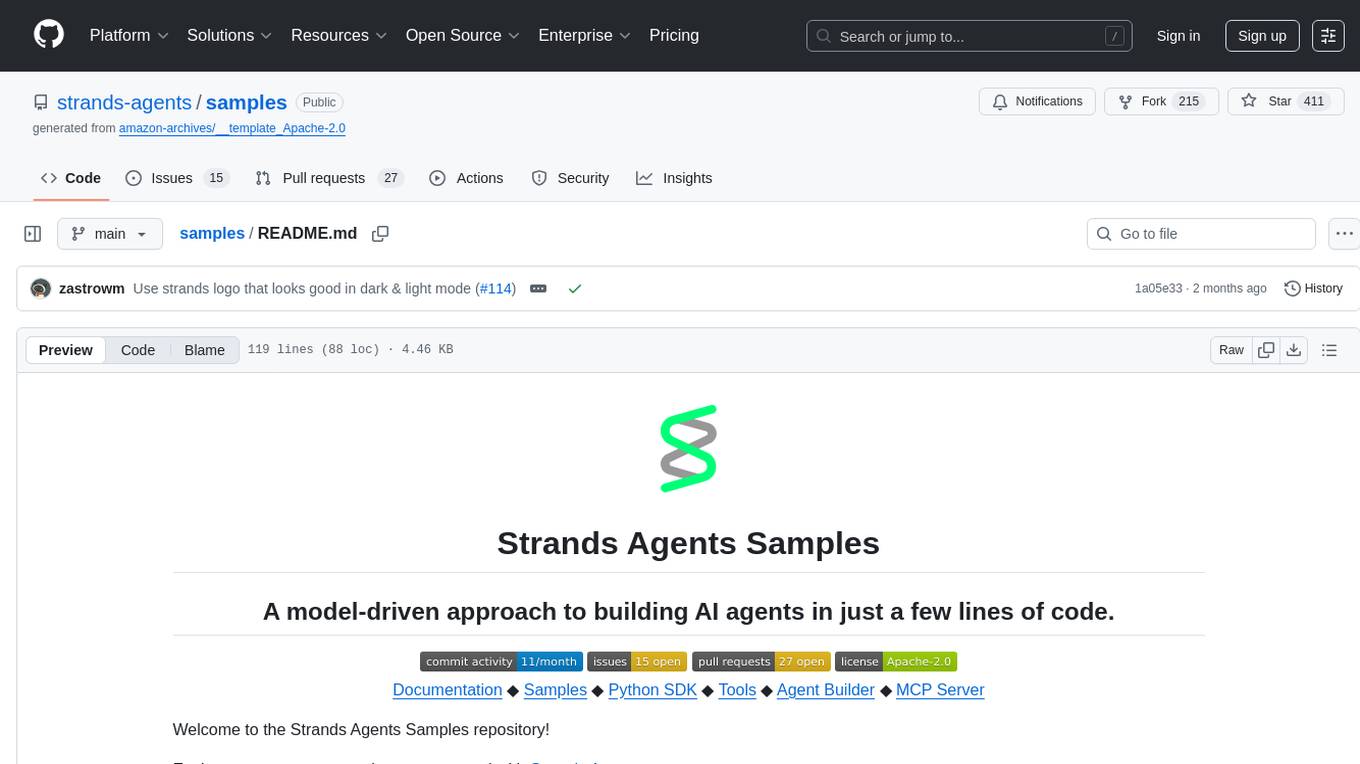
samples
Strands Agents Samples is a repository showcasing easy-to-use examples for building AI agents using a model-driven approach. The examples provided are for demonstration and educational purposes only, not intended for direct production use. Users can explore various samples to understand concepts and techniques, ensuring proper security and testing procedures before implementation.

kaito
Kaito is an operator that automates the AI/ML inference model deployment in a Kubernetes cluster. It manages large model files using container images, avoids tuning deployment parameters to fit GPU hardware by providing preset configurations, auto-provisions GPU nodes based on model requirements, and hosts large model images in the public Microsoft Container Registry (MCR) if the license allows. Using Kaito, the workflow of onboarding large AI inference models in Kubernetes is largely simplified.

griptape
Griptape is a modular Python framework for building AI-powered applications that securely connect to your enterprise data and APIs. It offers developers the ability to maintain control and flexibility at every step. Griptape's core components include Structures (Agents, Pipelines, and Workflows), Tasks, Tools, Memory (Conversation Memory, Task Memory, and Meta Memory), Drivers (Prompt and Embedding Drivers, Vector Store Drivers, Image Generation Drivers, Image Query Drivers, SQL Drivers, Web Scraper Drivers, and Conversation Memory Drivers), Engines (Query Engines, Extraction Engines, Summary Engines, Image Generation Engines, and Image Query Engines), and additional components (Rulesets, Loaders, Artifacts, Chunkers, and Tokenizers). Griptape enables developers to create AI-powered applications with ease and efficiency.

zep-python
Zep is an open-source platform for building and deploying large language model (LLM) applications. It provides a suite of tools and services that make it easy to integrate LLMs into your applications, including chat history memory, embedding, vector search, and data enrichment. Zep is designed to be scalable, reliable, and easy to use, making it a great choice for developers who want to build LLM-powered applications quickly and easily.
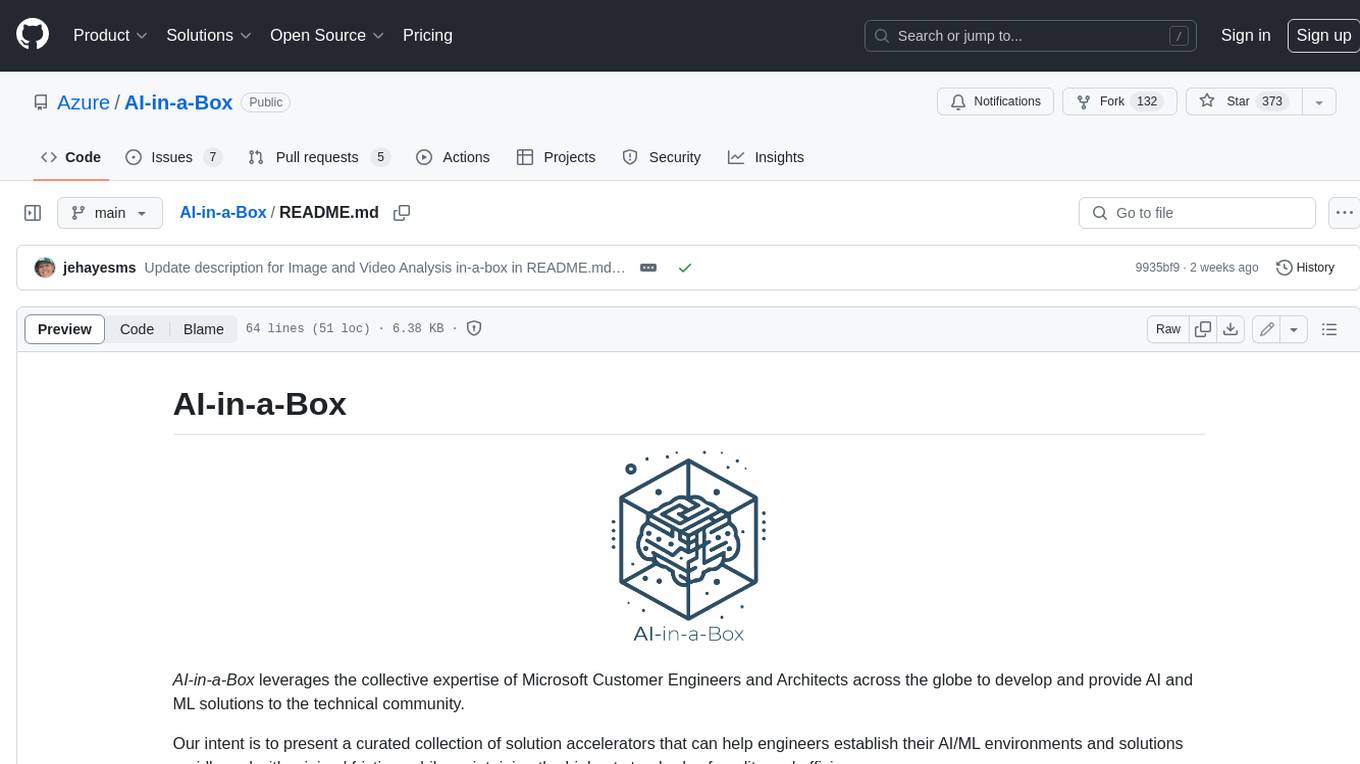
AI-in-a-Box
AI-in-a-Box is a curated collection of solution accelerators that can help engineers establish their AI/ML environments and solutions rapidly and with minimal friction, while maintaining the highest standards of quality and efficiency. It provides essential guidance on the responsible use of AI and LLM technologies, specific security guidance for Generative AI (GenAI) applications, and best practices for scaling OpenAI applications within Azure. The available accelerators include: Azure ML Operationalization in-a-box, Edge AI in-a-box, Doc Intelligence in-a-box, Image and Video Analysis in-a-box, Cognitive Services Landing Zone in-a-box, Semantic Kernel Bot in-a-box, NLP to SQL in-a-box, Assistants API in-a-box, and Assistants API Bot in-a-box.
For similar jobs
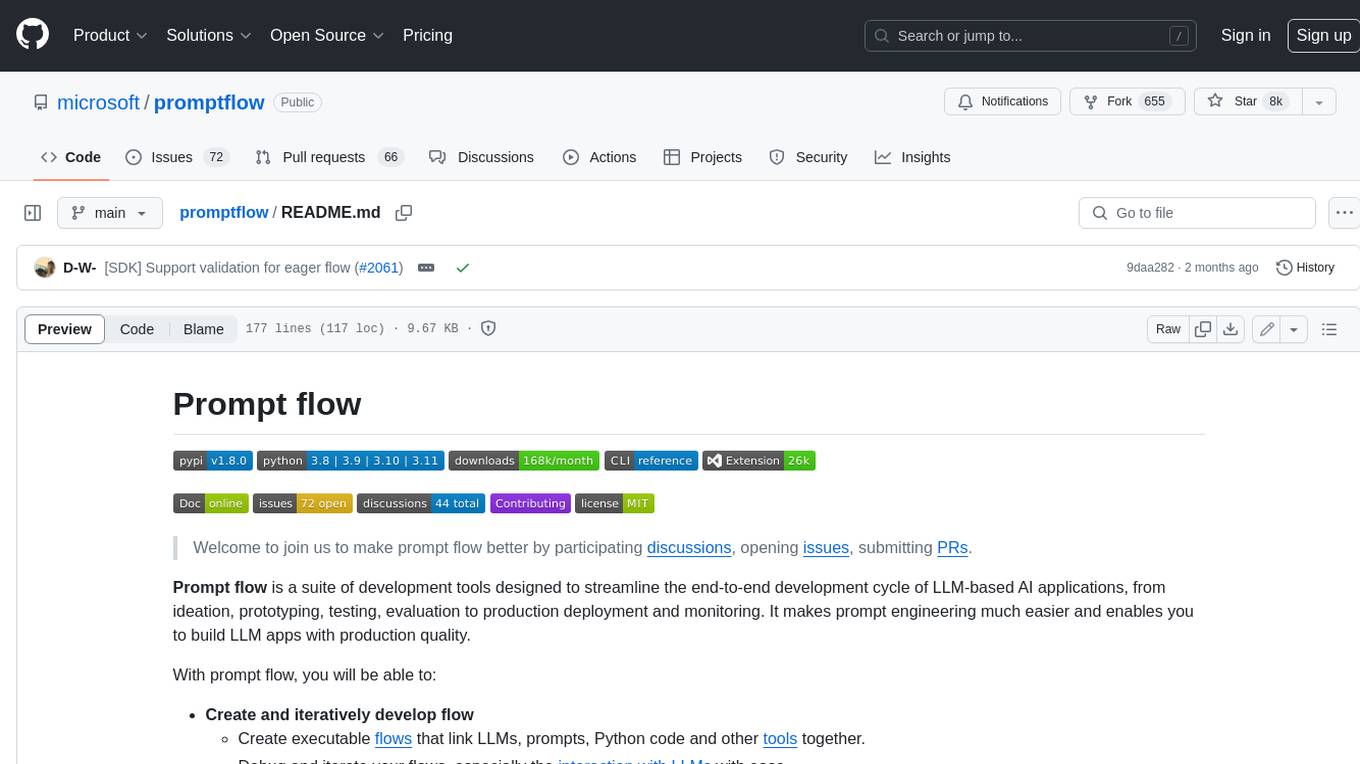
promptflow
**Prompt flow** is a suite of development tools designed to streamline the end-to-end development cycle of LLM-based AI applications, from ideation, prototyping, testing, evaluation to production deployment and monitoring. It makes prompt engineering much easier and enables you to build LLM apps with production quality.
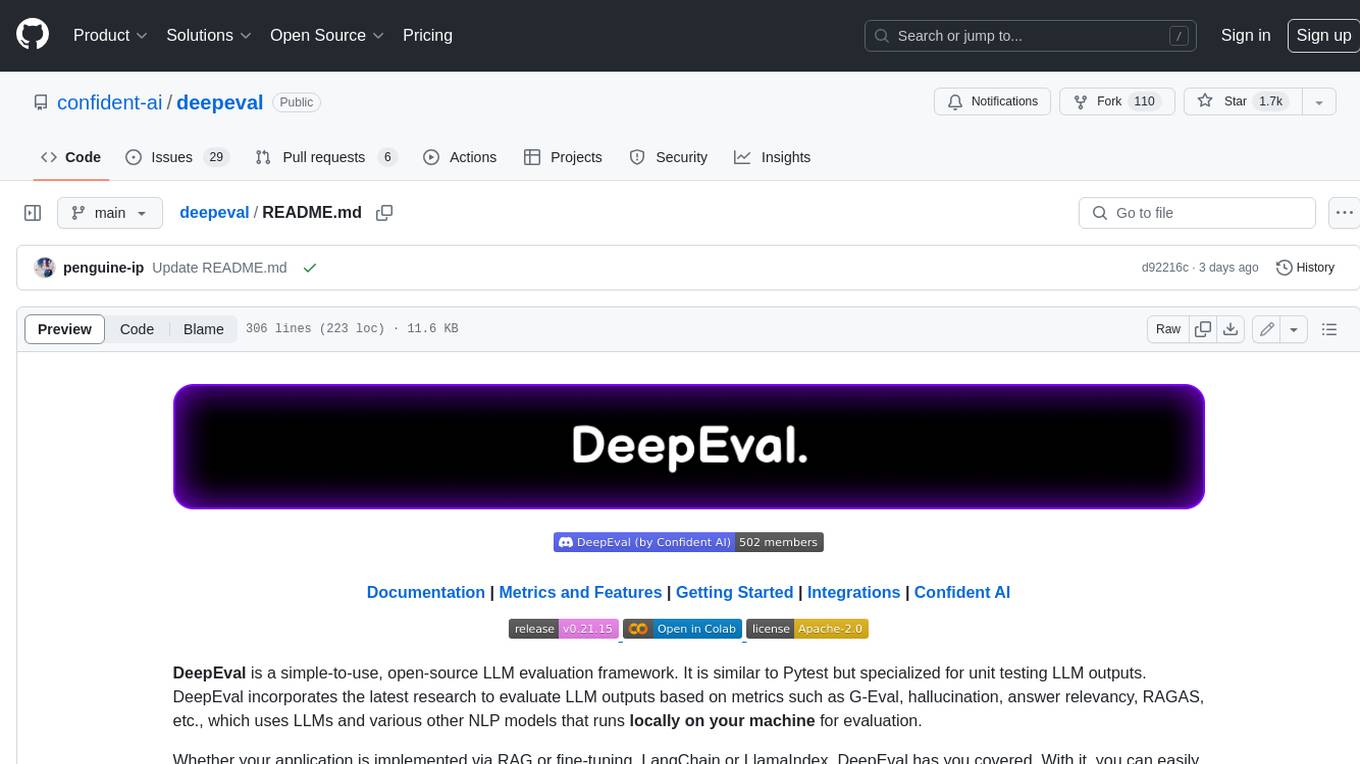
deepeval
DeepEval is a simple-to-use, open-source LLM evaluation framework specialized for unit testing LLM outputs. It incorporates various metrics such as G-Eval, hallucination, answer relevancy, RAGAS, etc., and runs locally on your machine for evaluation. It provides a wide range of ready-to-use evaluation metrics, allows for creating custom metrics, integrates with any CI/CD environment, and enables benchmarking LLMs on popular benchmarks. DeepEval is designed for evaluating RAG and fine-tuning applications, helping users optimize hyperparameters, prevent prompt drifting, and transition from OpenAI to hosting their own Llama2 with confidence.
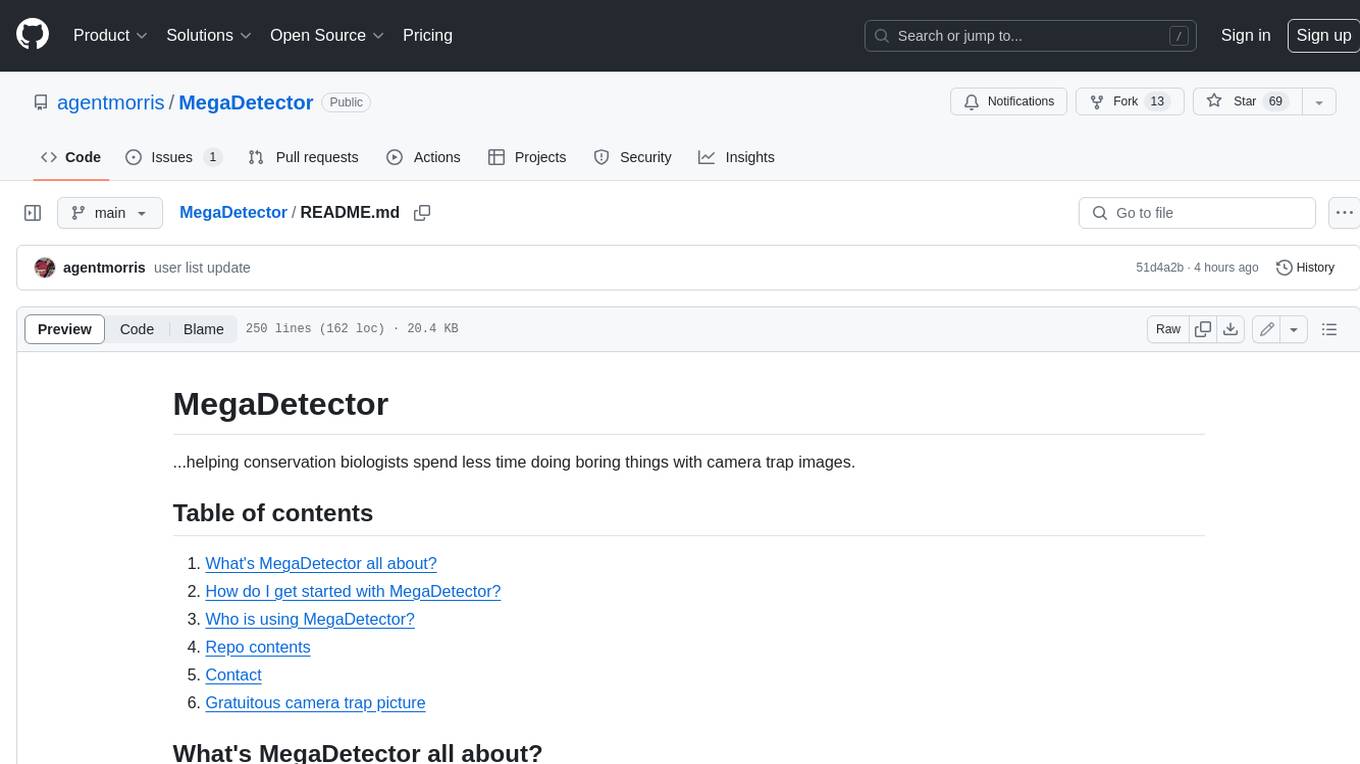
MegaDetector
MegaDetector is an AI model that identifies animals, people, and vehicles in camera trap images (which also makes it useful for eliminating blank images). This model is trained on several million images from a variety of ecosystems. MegaDetector is just one of many tools that aims to make conservation biologists more efficient with AI. If you want to learn about other ways to use AI to accelerate camera trap workflows, check out our of the field, affectionately titled "Everything I know about machine learning and camera traps".
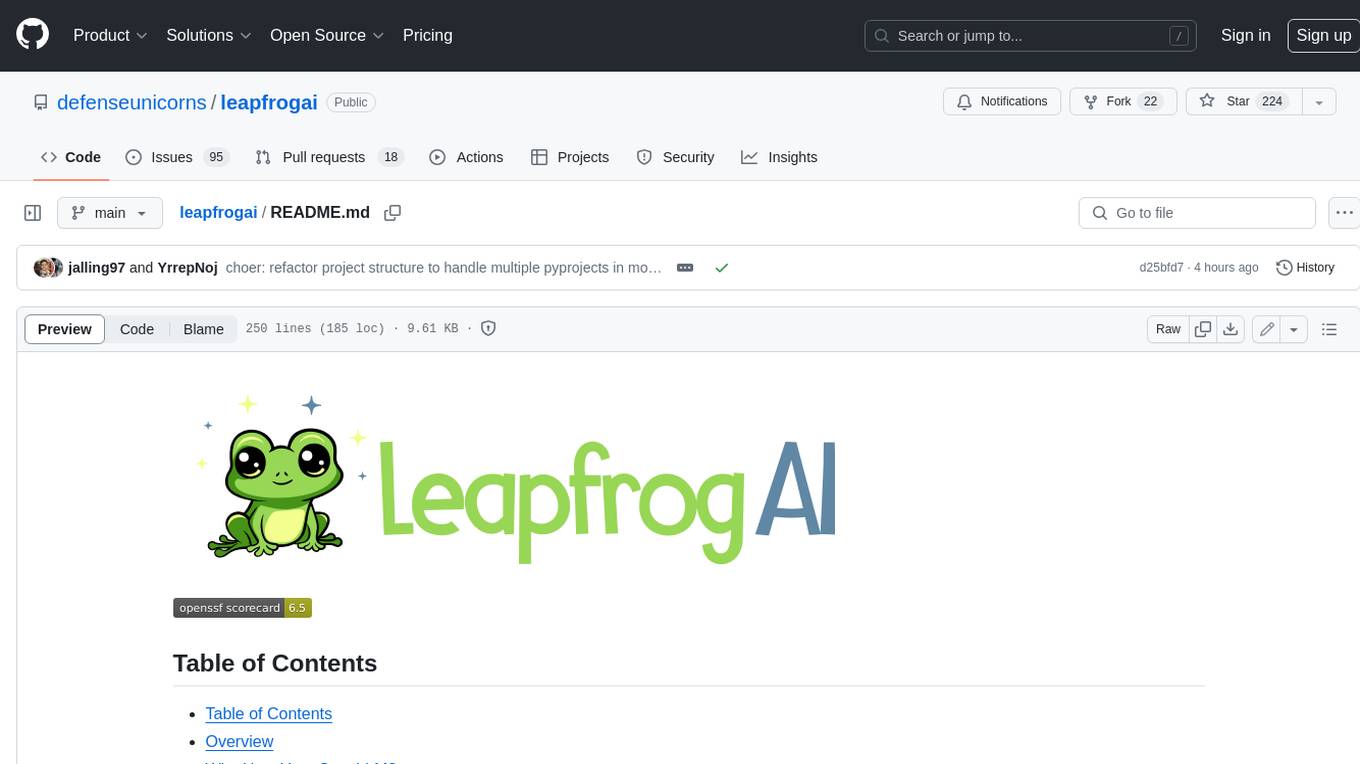
leapfrogai
LeapfrogAI is a self-hosted AI platform designed to be deployed in air-gapped resource-constrained environments. It brings sophisticated AI solutions to these environments by hosting all the necessary components of an AI stack, including vector databases, model backends, API, and UI. LeapfrogAI's API closely matches that of OpenAI, allowing tools built for OpenAI/ChatGPT to function seamlessly with a LeapfrogAI backend. It provides several backends for various use cases, including llama-cpp-python, whisper, text-embeddings, and vllm. LeapfrogAI leverages Chainguard's apko to harden base python images, ensuring the latest supported Python versions are used by the other components of the stack. The LeapfrogAI SDK provides a standard set of protobuffs and python utilities for implementing backends and gRPC. LeapfrogAI offers UI options for common use-cases like chat, summarization, and transcription. It can be deployed and run locally via UDS and Kubernetes, built out using Zarf packages. LeapfrogAI is supported by a community of users and contributors, including Defense Unicorns, Beast Code, Chainguard, Exovera, Hypergiant, Pulze, SOSi, United States Navy, United States Air Force, and United States Space Force.
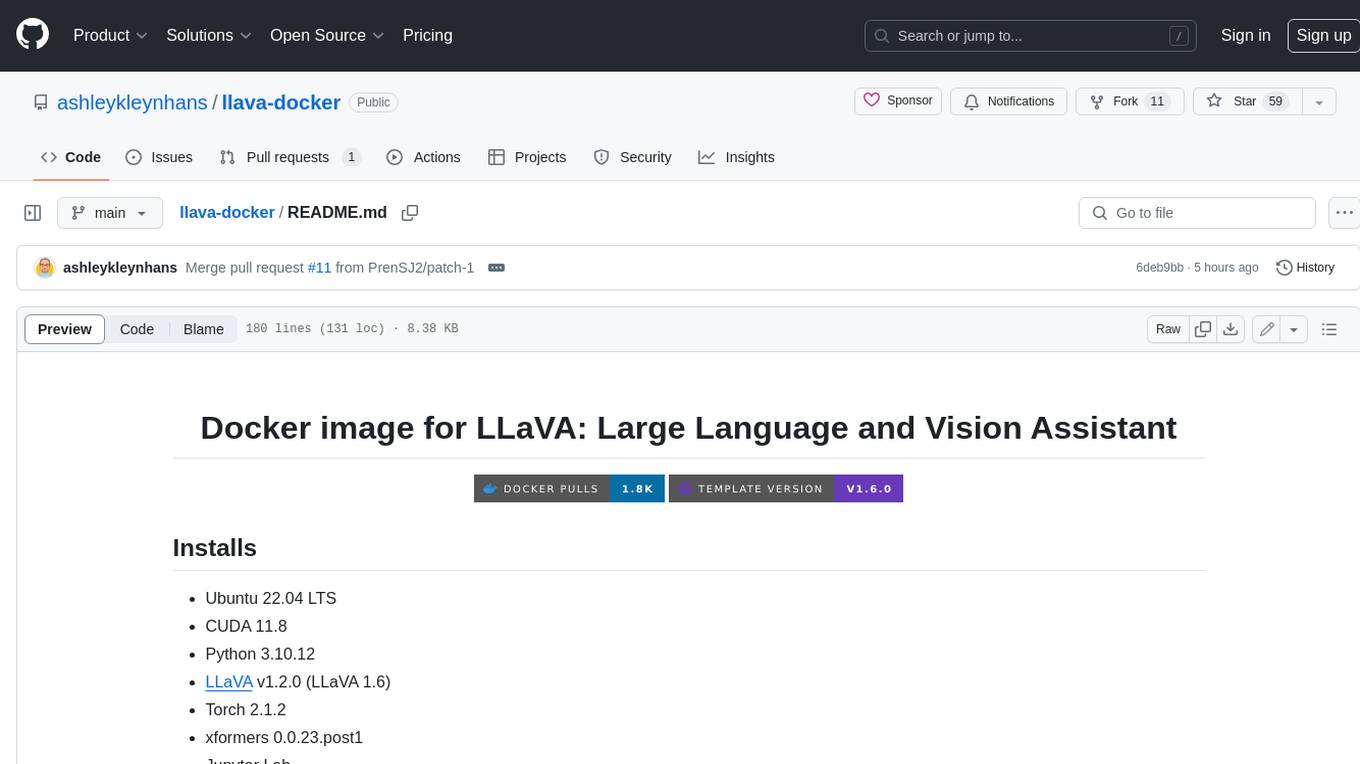
llava-docker
This Docker image for LLaVA (Large Language and Vision Assistant) provides a convenient way to run LLaVA locally or on RunPod. LLaVA is a powerful AI tool that combines natural language processing and computer vision capabilities. With this Docker image, you can easily access LLaVA's functionalities for various tasks, including image captioning, visual question answering, text summarization, and more. The image comes pre-installed with LLaVA v1.2.0, Torch 2.1.2, xformers 0.0.23.post1, and other necessary dependencies. You can customize the model used by setting the MODEL environment variable. The image also includes a Jupyter Lab environment for interactive development and exploration. Overall, this Docker image offers a comprehensive and user-friendly platform for leveraging LLaVA's capabilities.

carrot
The 'carrot' repository on GitHub provides a list of free and user-friendly ChatGPT mirror sites for easy access. The repository includes sponsored sites offering various GPT models and services. Users can find and share sites, report errors, and access stable and recommended sites for ChatGPT usage. The repository also includes a detailed list of ChatGPT sites, their features, and accessibility options, making it a valuable resource for ChatGPT users seeking free and unlimited GPT services.
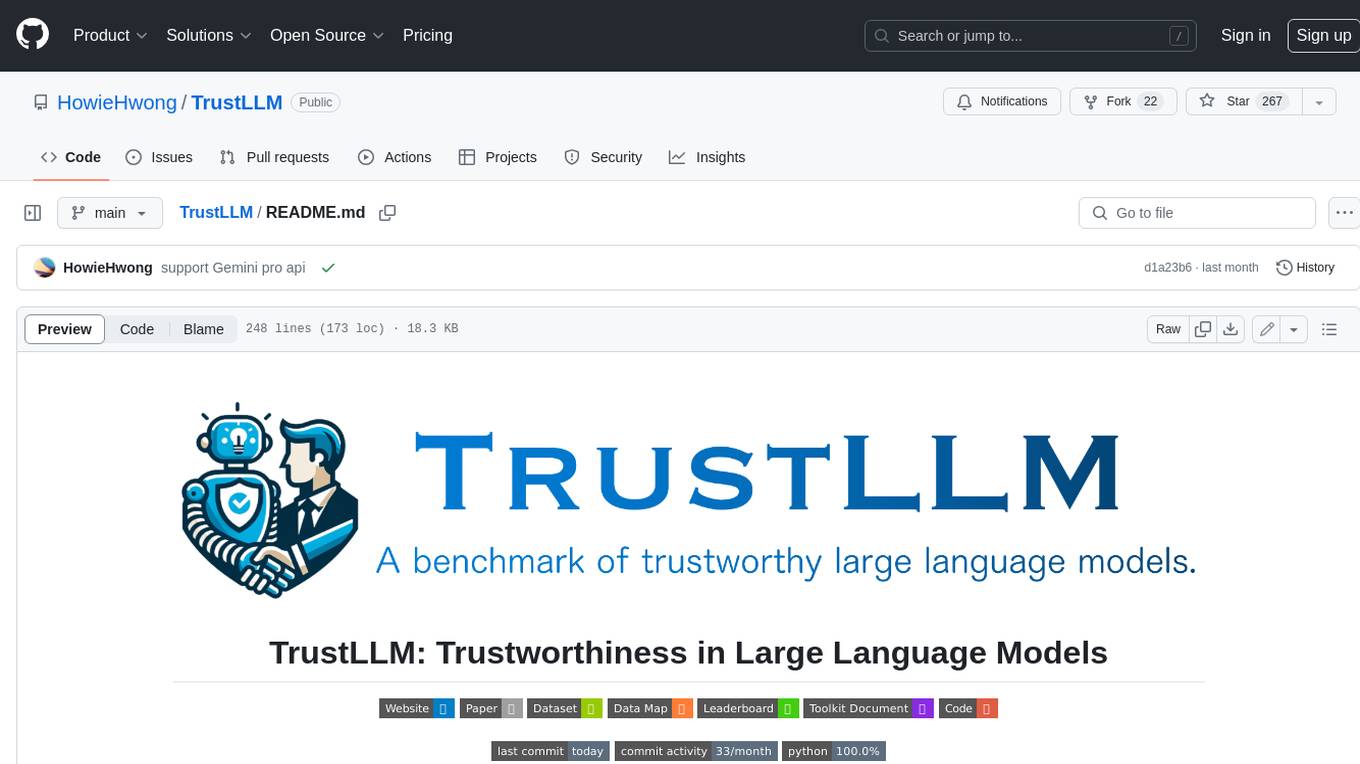
TrustLLM
TrustLLM is a comprehensive study of trustworthiness in LLMs, including principles for different dimensions of trustworthiness, established benchmark, evaluation, and analysis of trustworthiness for mainstream LLMs, and discussion of open challenges and future directions. Specifically, we first propose a set of principles for trustworthy LLMs that span eight different dimensions. Based on these principles, we further establish a benchmark across six dimensions including truthfulness, safety, fairness, robustness, privacy, and machine ethics. We then present a study evaluating 16 mainstream LLMs in TrustLLM, consisting of over 30 datasets. The document explains how to use the trustllm python package to help you assess the performance of your LLM in trustworthiness more quickly. For more details about TrustLLM, please refer to project website.
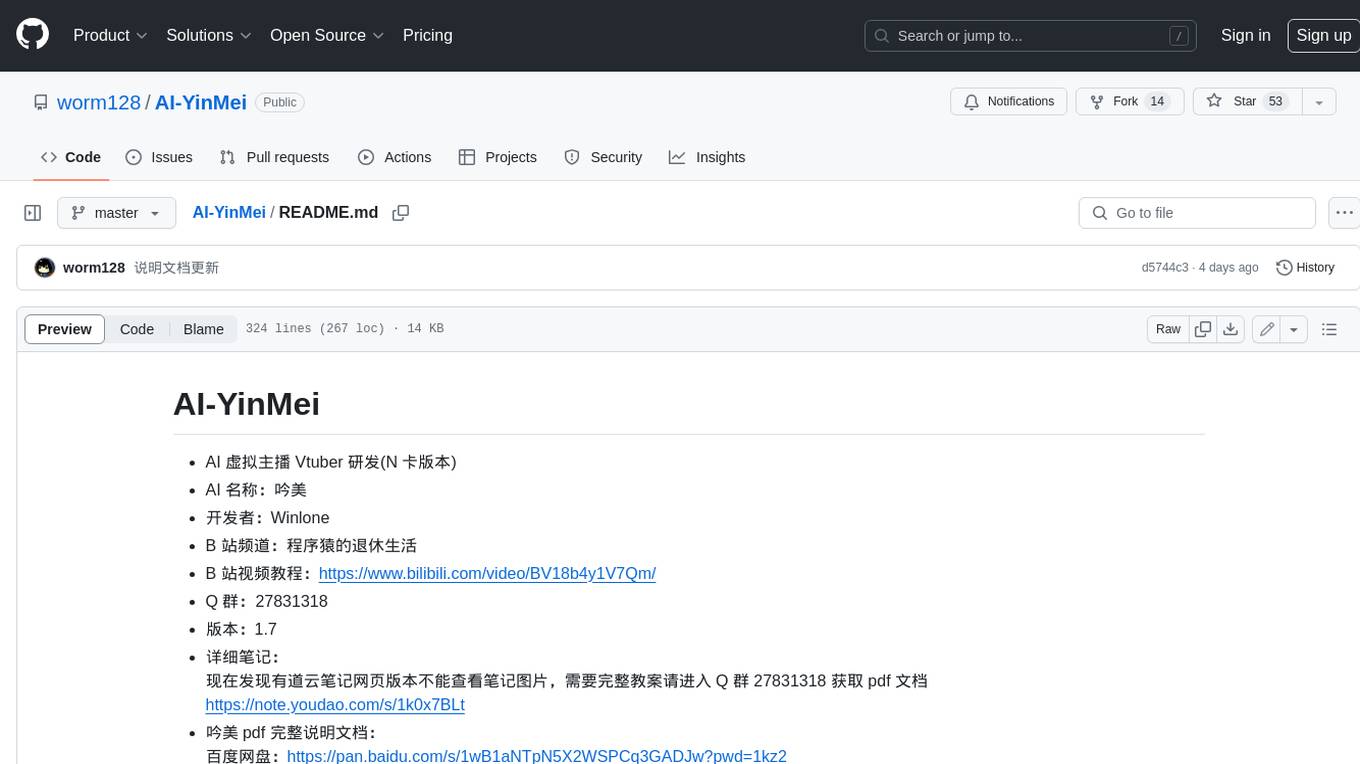
AI-YinMei
AI-YinMei is an AI virtual anchor Vtuber development tool (N card version). It supports fastgpt knowledge base chat dialogue, a complete set of solutions for LLM large language models: [fastgpt] + [one-api] + [Xinference], supports docking bilibili live broadcast barrage reply and entering live broadcast welcome speech, supports Microsoft edge-tts speech synthesis, supports Bert-VITS2 speech synthesis, supports GPT-SoVITS speech synthesis, supports expression control Vtuber Studio, supports painting stable-diffusion-webui output OBS live broadcast room, supports painting picture pornography public-NSFW-y-distinguish, supports search and image search service duckduckgo (requires magic Internet access), supports image search service Baidu image search (no magic Internet access), supports AI reply chat box [html plug-in], supports AI singing Auto-Convert-Music, supports playlist [html plug-in], supports dancing function, supports expression video playback, supports head touching action, supports gift smashing action, supports singing automatic start dancing function, chat and singing automatic cycle swing action, supports multi scene switching, background music switching, day and night automatic switching scene, supports open singing and painting, let AI automatically judge the content.




























